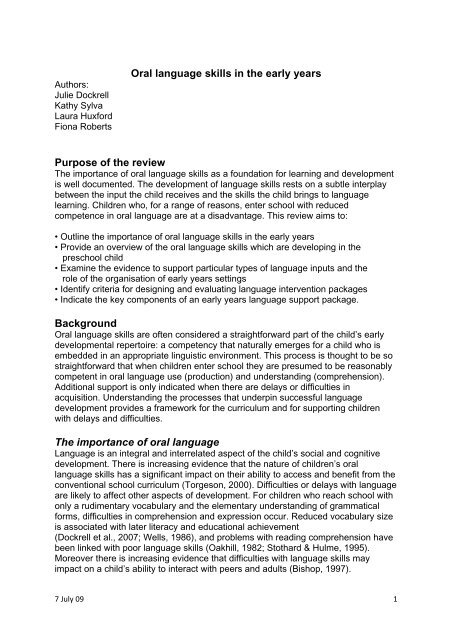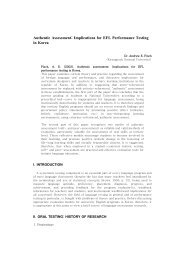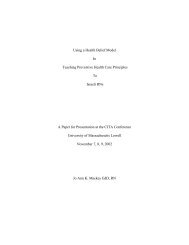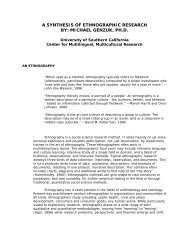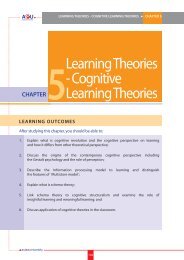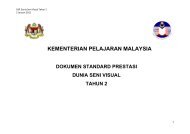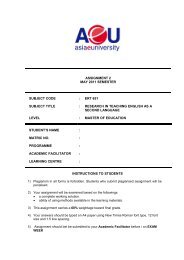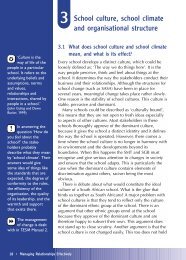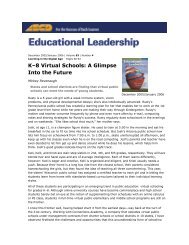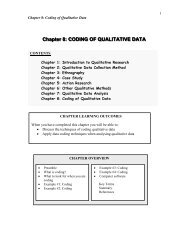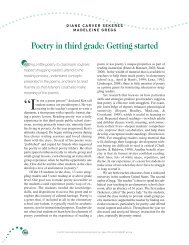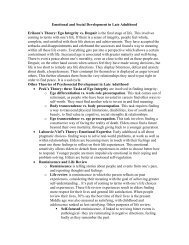Oral language skills in the early years
Oral language skills in the early years
Oral language skills in the early years
Create successful ePaper yourself
Turn your PDF publications into a flip-book with our unique Google optimized e-Paper software.
Authors:<br />
Julie Dockrell<br />
Kathy Sylva<br />
Laura Huxford<br />
Fiona Roberts<br />
<strong>Oral</strong> <strong>language</strong> <strong>skills</strong> <strong>in</strong> <strong>the</strong> <strong>early</strong> <strong>years</strong><br />
Purpose of <strong>the</strong> review<br />
The importance of oral <strong>language</strong> <strong>skills</strong> as a foundation for learn<strong>in</strong>g and development<br />
is well documented. The development of <strong>language</strong> <strong>skills</strong> rests on a subtle <strong>in</strong>terplay<br />
between <strong>the</strong> <strong>in</strong>put <strong>the</strong> child receives and <strong>the</strong> <strong>skills</strong> <strong>the</strong> child br<strong>in</strong>gs to <strong>language</strong><br />
learn<strong>in</strong>g. Children who, for a range of reasons, enter school with reduced<br />
competence <strong>in</strong> oral <strong>language</strong> are at a disadvantage. This review aims to:<br />
• Outl<strong>in</strong>e <strong>the</strong> importance of oral <strong>language</strong> <strong>skills</strong> <strong>in</strong> <strong>the</strong> <strong>early</strong> <strong>years</strong><br />
• Provide an overview of <strong>the</strong> oral <strong>language</strong> <strong>skills</strong> which are develop<strong>in</strong>g <strong>in</strong> <strong>the</strong><br />
preschool child<br />
• Exam<strong>in</strong>e <strong>the</strong> evidence to support particular types of <strong>language</strong> <strong>in</strong>puts and <strong>the</strong><br />
role of <strong>the</strong> organisation of <strong>early</strong> <strong>years</strong> sett<strong>in</strong>gs<br />
• Identify criteria for design<strong>in</strong>g and evaluat<strong>in</strong>g <strong>language</strong> <strong>in</strong>tervention packages<br />
• Indicate <strong>the</strong> key components of an <strong>early</strong> <strong>years</strong> <strong>language</strong> support package.<br />
Background<br />
<strong>Oral</strong> <strong>language</strong> <strong>skills</strong> are often considered a straightforward part of <strong>the</strong> child’s <strong>early</strong><br />
developmental repertoire: a competency that naturally emerges for a child who is<br />
embedded <strong>in</strong> an appropriate l<strong>in</strong>guistic environment. This process is thought to be so<br />
straightforward that when children enter school <strong>the</strong>y are presumed to be reasonably<br />
competent <strong>in</strong> oral <strong>language</strong> use (production) and understand<strong>in</strong>g (comprehension).<br />
Additional support is only <strong>in</strong>dicated when <strong>the</strong>re are delays or difficulties <strong>in</strong><br />
acquisition. Understand<strong>in</strong>g <strong>the</strong> processes that underp<strong>in</strong> successful <strong>language</strong><br />
development provides a framework for <strong>the</strong> curriculum and for support<strong>in</strong>g children<br />
with delays and difficulties.<br />
The importance of oral <strong>language</strong><br />
Language is an <strong>in</strong>tegral and <strong>in</strong>terrelated aspect of <strong>the</strong> child’s social and cognitive<br />
development. There is <strong>in</strong>creas<strong>in</strong>g evidence that <strong>the</strong> nature of children’s oral<br />
<strong>language</strong> <strong>skills</strong> has a significant impact on <strong>the</strong>ir ability to access and benefit from <strong>the</strong><br />
conventional school curriculum (Torgeson, 2000). Difficulties or delays with <strong>language</strong><br />
are likely to affect o<strong>the</strong>r aspects of development. For children who reach school with<br />
only a rudimentary vocabulary and <strong>the</strong> elementary understand<strong>in</strong>g of grammatical<br />
forms, difficulties <strong>in</strong> comprehension and expression occur. Reduced vocabulary size<br />
is associated with later literacy and educational achievement<br />
(Dockrell et al., 2007; Wells, 1986), and problems with read<strong>in</strong>g comprehension have<br />
been l<strong>in</strong>ked with poor <strong>language</strong> <strong>skills</strong> (Oakhill, 1982; Stothard & Hulme, 1995).<br />
Moreover <strong>the</strong>re is <strong>in</strong>creas<strong>in</strong>g evidence that difficulties with <strong>language</strong> <strong>skills</strong> may<br />
impact on a child’s ability to <strong>in</strong>teract with peers and adults (Bishop, 1997).<br />
7 July 09 1
Causes of <strong>language</strong> delays and difficulties<br />
Reduced oral <strong>language</strong> <strong>skills</strong> can result from a range of causes. Some children will<br />
not have received sufficient exposure to <strong>the</strong> <strong>language</strong> used <strong>in</strong> school contexts. This<br />
may occur because of reduced exposure <strong>in</strong> <strong>the</strong> <strong>early</strong> <strong>years</strong> or because <strong>the</strong> <strong>language</strong><br />
of school is not <strong>the</strong> child’s primary <strong>language</strong>. O<strong>the</strong>r children may struggle with<br />
acquir<strong>in</strong>g <strong>the</strong> <strong>language</strong> system as a result of developmental difficulties. For some <strong>the</strong><br />
double jeopardy of disadvantage and developmental difficulties will compromise <strong>the</strong>ir<br />
developmental pathways.<br />
Children experience significant differences <strong>in</strong> <strong>the</strong> amount of oral <strong>language</strong> <strong>in</strong>put <strong>the</strong>y<br />
receive (Clarke-Stewart, 1973; Hart & Risley, 1992; 1995; Wells, 1986) and<br />
socioeconomic <strong>in</strong>dices are related to differences <strong>in</strong> <strong>the</strong> amount of time spent talk<strong>in</strong>g<br />
with children (Hart & Risley, 1995). Children from economically deprived<br />
backgrounds are at considerable risk of <strong>language</strong> delay (Locke, G<strong>in</strong>sborg, & Peers,<br />
2002). O<strong>the</strong>r groups of children may be placed at risk because of <strong>the</strong> <strong>in</strong>teraction<br />
between <strong>the</strong>ir own <strong>skills</strong> and experiences and <strong>the</strong> educational context <strong>in</strong>to which <strong>the</strong>y<br />
enter. For example many children <strong>in</strong> <strong>the</strong> UK for whom English is a second <strong>language</strong><br />
may not be provided with <strong>the</strong> appropriate opportunities to develop <strong>the</strong>ir English<br />
<strong>language</strong> <strong>skills</strong> and consequently may suffer from underachievement. These<br />
difficulties have often been l<strong>in</strong>ked to relatively “low levels of English fluency as <strong>the</strong><br />
children enter <strong>the</strong> education system” (Hutch<strong>in</strong>son et al., 2003). Thus children<br />
develop<strong>in</strong>g <strong>in</strong> different l<strong>in</strong>guistic and cultural contexts may experience barriers <strong>in</strong><br />
meet<strong>in</strong>g <strong>the</strong> demands of <strong>the</strong> ma<strong>in</strong>stream curriculum. Yet, <strong>the</strong> use of a specific oral<br />
<strong>language</strong> register is fundamental to becom<strong>in</strong>g literate <strong>in</strong> school (Pelligr<strong>in</strong>i, 2002).<br />
Developmental difficulties also often compromise <strong>the</strong> <strong>language</strong> system. Some<br />
children experience difficulties which are primarily related to <strong>language</strong> which cannot<br />
be expla<strong>in</strong>ed by lack of experience, general ability or hear<strong>in</strong>g difficulties (Bishop,<br />
1997; Leonard, 1998). They form a sizeable group of <strong>the</strong> preschool population<br />
(prevalence rate of 7.4% at school entry (Tombl<strong>in</strong> et al., 1997). Children with o<strong>the</strong>r<br />
developmental difficulties, <strong>in</strong>clud<strong>in</strong>g moderate learn<strong>in</strong>g difficulties, also can<br />
experience <strong>language</strong> delays which are more varied than would be expected on <strong>the</strong><br />
basis of <strong>the</strong>ir o<strong>the</strong>r <strong>skills</strong> (e.g., Volterra, Capirci, & Capelli, 2001). The majority of<br />
children experienc<strong>in</strong>g <strong>language</strong> delays and difficulties will be found <strong>in</strong> ma<strong>in</strong>stream<br />
<strong>early</strong> <strong>years</strong> sett<strong>in</strong>gs (L<strong>in</strong>dsay et al., 2005). Thus, <strong>the</strong>re is a cont<strong>in</strong>u<strong>in</strong>g need for staff<br />
to be sensitive to children’s <strong>language</strong> competencies, skilled at support<strong>in</strong>g oral<br />
<strong>language</strong> and aware when systematic attempts to support oral <strong>language</strong> difficulties<br />
are not effective (see discussions about response to treatment/<strong>in</strong>tervention, Fuchs,<br />
2003; Vaughn, L<strong>in</strong>an-Thompson, & Hickman, 2003).<br />
<strong>Oral</strong> <strong>language</strong> as a foundation skill<br />
The <strong>language</strong> system serves a number of quite diverse purposes. Primarily it is a<br />
system of representations. As a representational system it allows us to represent<br />
and <strong>in</strong>terpret <strong>the</strong> situations and contexts <strong>in</strong> which we f<strong>in</strong>d ourselves, represent our<br />
wishes and negotiate social situations, represent our ideas and knowledge to <strong>the</strong><br />
o<strong>the</strong>rs and provide a medium for develop<strong>in</strong>g and ref<strong>in</strong><strong>in</strong>g our own ideas. Thus, oral<br />
<strong>language</strong> provides <strong>the</strong> basic <strong>in</strong>frastructure that supports <strong>the</strong> development of a range<br />
of cognitive and social processes. Delays or difficulties <strong>in</strong> <strong>the</strong> development of oral<br />
<strong>language</strong> constitutes a risk factor for o<strong>the</strong>r aspects of academic and social<br />
development.<br />
7 July 09 2
<strong>Oral</strong> <strong>language</strong> and literacy<br />
<strong>Oral</strong> <strong>language</strong> difficulties <strong>in</strong> <strong>the</strong> preschool <strong>years</strong> compromise successful literacy<br />
acquisition (Aram & Nation, 1980; Catts, 1993; Wilson & Risucci, 1988). A strong<br />
<strong>language</strong> base is required for read<strong>in</strong>g (NICHD, 2005; ECCRN, 2002). It is <strong>the</strong>refore<br />
not surpris<strong>in</strong>g that children who experience difficulties with oral <strong>language</strong> frequently<br />
experience difficulties with literacy. By corollary many poor readers also experience<br />
difficulties with oral <strong>language</strong>. Recently Catts, Fey, Zhang and Tombl<strong>in</strong> (1999)<br />
estimated that as many as 50% of poor readers have <strong>language</strong> deficits that go<br />
beyond phonological process<strong>in</strong>g. These problems <strong>in</strong>clude difficulties with expressive<br />
and receptive vocabulary and syntax or wider problems with comprehension of text<br />
and <strong>in</strong>ference. Thus <strong>the</strong>re are clear l<strong>in</strong>ks between oral <strong>language</strong> and literacy,<br />
although <strong>the</strong> nature of <strong>the</strong>se relationships maybe complex (Storch & Whitehurst,<br />
2002). In <strong>the</strong> developmental phases prior to literacy and dur<strong>in</strong>g <strong>the</strong> <strong>in</strong>itial phases of<br />
literacy acquisition explicit support for <strong>the</strong> development of oral <strong>language</strong> <strong>skills</strong> is<br />
advocated. The key question is which oral <strong>language</strong> <strong>skills</strong> should be targeted and<br />
how should <strong>the</strong>se be targeted?<br />
The importance of phonological <strong>skills</strong> as a key factor <strong>in</strong> word decod<strong>in</strong>g is now firmly<br />
established (National Read<strong>in</strong>g Panel, 2000). In contrast <strong>the</strong> importance of o<strong>the</strong>r<br />
<strong>language</strong> competencies, such as grammar and morphology, and <strong>the</strong> ways <strong>in</strong> which<br />
<strong>the</strong>se support read<strong>in</strong>g is more complex (Roth et al., 1996; Scarborough, 1989;<br />
Schatschneider et al., 2004). Early studies <strong>in</strong>dicated that <strong>the</strong> l<strong>in</strong>ks between<br />
<strong>language</strong> and read<strong>in</strong>g were <strong>in</strong>direct, such that vocabulary was seen as <strong>the</strong> basis for<br />
acquisition of phonological knowledge dur<strong>in</strong>g <strong>the</strong> preschool period and phonology<br />
(not vocabulary) was assumed to underlie <strong>the</strong> acquisition of read<strong>in</strong>g (Whitehurst &<br />
Lonigan, 1998). These conclusions are challenged both by evidence from older<br />
children, who while competent at decod<strong>in</strong>g show poor comprehension <strong>skills</strong>, and<br />
recent longitud<strong>in</strong>al studies, highlight<strong>in</strong>g <strong>the</strong> importance of oral <strong>language</strong> <strong>in</strong> <strong>early</strong><br />
read<strong>in</strong>g. There is <strong>in</strong>creas<strong>in</strong>g evidence that children with normally develop<strong>in</strong>g<br />
decod<strong>in</strong>g <strong>skills</strong> but poor read<strong>in</strong>g comprehension <strong>skills</strong> exhibit difficulties <strong>in</strong> o<strong>the</strong>r<br />
areas of <strong>the</strong> <strong>language</strong> system (Bishop & Adams, 1992; Messer, Dockrell, & Murphy,<br />
2004; Nation & Norbury, 2005; Stothard & Hulme, 1992). These data illustrate <strong>the</strong><br />
ways <strong>in</strong> which oral <strong>language</strong> <strong>skills</strong> can differentially <strong>in</strong>fluence literacy development.<br />
Sentence and text comprehension are both affected by children’s oral <strong>language</strong><br />
<strong>skills</strong> and <strong>the</strong>ir general verbal ability (Snow et al., 1991; Storch & Whitehurst, 2002).<br />
Early read<strong>in</strong>g <strong>skills</strong> are related to both <strong>early</strong> <strong>language</strong> and phonemic knowledge<br />
(NICHD, 2005; Poe, Burch<strong>in</strong>al, & Roberts, 2004) and it is <strong>the</strong> contribution of a broad<br />
range of oral <strong>language</strong> <strong>skills</strong> that contribute unique variance to predictions of<br />
read<strong>in</strong>g competence (NICHD, 2005). Results of studies <strong>in</strong> literacy (NICHD, 2005)<br />
and <strong>language</strong> (Tombl<strong>in</strong> & Zhang, 2006) are highlight<strong>in</strong>g <strong>the</strong> importance of <strong>the</strong><br />
<strong>in</strong>terrelated nature of oral <strong>language</strong> <strong>skills</strong>. There is <strong>the</strong>refore a need for both a<br />
comprehensive assessment of <strong>language</strong> <strong>skills</strong> <strong>in</strong> <strong>the</strong> <strong>early</strong> <strong>years</strong> (Hirsh-Pasek et al.,<br />
2005) and <strong>the</strong> creation of <strong>in</strong>terventions which develop <strong>the</strong>se diverse <strong>skills</strong> <strong>in</strong> an<br />
evidence based fashion (Dockrell, Stuart, & K<strong>in</strong>g, 2006).<br />
<strong>Oral</strong> <strong>language</strong> and social emotional competence<br />
Language also serves a fundamental role <strong>in</strong> <strong>in</strong>terpersonal contacts, relationship<br />
formation, regulation of <strong>in</strong>teractions, and <strong>the</strong> socialisation of children (Cohen, 2005).<br />
The relationship between social and emotional competence and <strong>language</strong> ability<br />
appears to be reciprocal: <strong>language</strong> serves to support social <strong>in</strong>teractions and social<br />
7 July 09 3
<strong>in</strong>teractions provide a context to fur<strong>the</strong>r develop l<strong>in</strong>guistic <strong>skills</strong>. These <strong>skills</strong> are<br />
supported by <strong>in</strong>teractions with adults and peers where opportunities for establish<strong>in</strong>g<br />
and practic<strong>in</strong>g <strong>language</strong> <strong>skills</strong>, role modell<strong>in</strong>g, and offer<strong>in</strong>g feedback are provided<br />
(Gallagher, 1999; W<strong>in</strong>dsor, 1995).<br />
Peer acceptance and sociometric status rat<strong>in</strong>gs are also related to communicative<br />
competence <strong>in</strong> both school aged and preschool children; with conversational <strong>skills</strong><br />
<strong>in</strong>fluenc<strong>in</strong>g peer acceptance <strong>in</strong> children as young as three (Kemple, Speranza, &<br />
Hazen,1992). These <strong>skills</strong> <strong>in</strong>clude <strong>the</strong> ability to <strong>in</strong>itiate conversation appropriately,<br />
contribute to ongo<strong>in</strong>g conversations, communicate <strong>in</strong>tentions cl<strong>early</strong>, present more<br />
positive than negative comments, and make adjustments <strong>in</strong> communication to suit<br />
<strong>the</strong> listener’s needs (Br<strong>in</strong>ton & Fujiki, 1999; Dodge et al., 1986; Gallagher, 1999).<br />
Difficulties <strong>in</strong> <strong>the</strong>se areas are l<strong>in</strong>ked to behavioural, emotional and social difficulties<br />
(Cantwell & Baker, 1987; Cohen et al., 1998; McCabe, 2005; Toppelberg & Shapiro,<br />
2000). A study of three year olds <strong>in</strong> <strong>the</strong> late 1970s po<strong>in</strong>ted to <strong>the</strong> high comorbidity of<br />
<strong>language</strong> delay and behaviour problems, 59% of <strong>the</strong> <strong>language</strong> delayed children<br />
experienced behaviour difficulties compared to only 14% of <strong>the</strong> non-<strong>language</strong><br />
delayed children (Richman & Stevenson, 1977; Richman, Stevenson & Graham,<br />
1975; Stevenson & Richman, 1976; 1978). These f<strong>in</strong>d<strong>in</strong>gs have been corroborated<br />
by a number of subsequent studies (McGee & Silva, 1982; Silva, 1980; Silva,<br />
Williams & McGee, 1987).<br />
Conclusion<br />
There is <strong>in</strong>creas<strong>in</strong>g evidence that <strong>early</strong> oral <strong>language</strong> <strong>skills</strong> are a fundamental<br />
stepp<strong>in</strong>g stone for children’s development. One of <strong>the</strong> ma<strong>in</strong> effects of poor oral<br />
<strong>language</strong> <strong>skills</strong> will be on children’s ability to develop adequate literacy <strong>skills</strong>. In<br />
addition <strong>the</strong>re will be more general effects on o<strong>the</strong>r aspects of <strong>the</strong> curriculum and <strong>in</strong><br />
children’s develop<strong>in</strong>g social and emotional competence. Early <strong>language</strong><br />
environments provide a unique opportunity to enhance (or h<strong>in</strong>der) <strong>language</strong><br />
development.<br />
What are <strong>the</strong> key <strong>early</strong> <strong>language</strong> milestones and key <strong>language</strong><br />
features?<br />
The <strong>language</strong> system is composed of a number of subcomponents that are<br />
important for effective understand<strong>in</strong>g and communication (Hirsh-Pasek et al., 2005).<br />
These <strong>in</strong>clude phonology, lexicon, grammar, and pragmatics. The key elements of<br />
<strong>the</strong> <strong>language</strong> system are presented <strong>in</strong> Table 3.1 (for a detailed discussion see Hoff,<br />
2004). Details of phonological processes are documented <strong>in</strong> detail of a range of<br />
texts and will not be discussed <strong>in</strong> detail here.<br />
7 July 09 4
Table 3.1<br />
Key components of <strong>the</strong> <strong>language</strong> system<br />
Language skill Def<strong>in</strong>ition Elaboration<br />
Phonology<br />
The ability to discrim<strong>in</strong>ate<br />
and produce <strong>the</strong> various<br />
sounds of <strong>the</strong> <strong>language</strong><br />
system<br />
Also <strong>in</strong>volves <strong>the</strong> rules for comb<strong>in</strong><strong>in</strong>g sounds <strong>in</strong><br />
spoken <strong>language</strong>. Speakers of English, for example,<br />
know that an English word can end, but not beg<strong>in</strong>,<br />
with an "‐ng" sound.<br />
Lexicon<br />
(vocabulary)<br />
Individual words that are<br />
understood and produced<br />
Words are made up of morphemes. These are <strong>the</strong><br />
smallest units of mean<strong>in</strong>g, paper is one morpheme<br />
but papers is 2 "paper" + "s”.<br />
Grammar<br />
(syntax)<br />
Rules that enable us to<br />
comb<strong>in</strong>e morphemes <strong>in</strong>to<br />
sentences and understand<br />
sentences or phrases.<br />
Syntactic rules become <strong>in</strong>creas<strong>in</strong>gly complex as <strong>the</strong><br />
child develops. From comb<strong>in</strong><strong>in</strong>g two morphemes,<br />
<strong>the</strong> child goes on to comb<strong>in</strong>e words with suffixes or<br />
<strong>in</strong>flections ("‐s" or "‐<strong>in</strong>g", as <strong>in</strong> "papers" and<br />
"eat<strong>in</strong>g") and eventually creates questions,<br />
statements and commands. This also allows for <strong>the</strong><br />
possibility of comb<strong>in</strong><strong>in</strong>g several ideas <strong>in</strong>to one<br />
complex sentence.<br />
Pragmatics Ability to speak<br />
appropriately <strong>in</strong> different<br />
situations.<br />
Includes greet<strong>in</strong>g, <strong>in</strong>form<strong>in</strong>g, demand<strong>in</strong>g, promis<strong>in</strong>g,<br />
and request<strong>in</strong>g; adapt<strong>in</strong>g or chang<strong>in</strong>g <strong>language</strong><br />
accord<strong>in</strong>g to <strong>the</strong> needs or expectations of a listener<br />
or situation; appropriate use of nonverbal signals <strong>in</strong><br />
conversation: distance between speaker and<br />
listener, facial expressions, and eye contact.<br />
7 July 09 5
Pragmatic aspects are often culturally determ<strong>in</strong>ed.<br />
Vocabulary<br />
Vocabulary is central to comprehension and content learn<strong>in</strong>g. It is easy to take for<br />
granted that words mean someth<strong>in</strong>g, but children learn<strong>in</strong>g <strong>language</strong> have to work<br />
this out for <strong>the</strong>mselves. They have to isolate sound patterns from <strong>the</strong> stream of<br />
<strong>language</strong> that <strong>the</strong>y hear and l<strong>in</strong>k that sound pattern to an object or event <strong>in</strong> <strong>the</strong> world<br />
around <strong>the</strong>m. Most children say <strong>the</strong>ir first word around <strong>the</strong>ir first birthday. This is <strong>the</strong><br />
beg<strong>in</strong>n<strong>in</strong>g of a life long process of vocabulary acquisition. Dur<strong>in</strong>g <strong>the</strong> preschool<br />
<strong>years</strong> vocabulary expansion is focussed around <strong>the</strong> development of a wide range of<br />
concrete object names and action words. This is supplemented by <strong>the</strong> use<br />
adjectives and adverbs that describe objects and qualify verbs.<br />
Vocabulary acquisition is facilitated when children are actively engaged <strong>in</strong> a task<br />
(Elley, 1989). Such active engagement needs to be complemented by <strong>the</strong><br />
occurrence of complex words (Wiezman & Snow, 2001) and appropriate syntactic<br />
structures (Hoff & Naigles, 2002), which can support <strong>the</strong> children’s hypo<strong>the</strong>ses<br />
about <strong>the</strong> <strong>in</strong>tended referent of a novel term. In addition to lexical development<br />
specific features of <strong>the</strong> oral <strong>language</strong> <strong>in</strong>put can also support grammatical<br />
development. For example an important determ<strong>in</strong>ant of verb use by young children<br />
is <strong>the</strong> specific pattern of verb use <strong>in</strong> <strong>the</strong> <strong>in</strong>put <strong>the</strong>y receive (Theakston et al., 2001).<br />
Grammar<br />
Vocabulary growth is <strong>in</strong>timately related to grammatical development (Hirsh-Pasek,<br />
et al., 2005). Children typically move from produc<strong>in</strong>g one-word utterances to two<br />
word utterances by <strong>the</strong> age of two. Grammatical development from this po<strong>in</strong>t <strong>in</strong><br />
development can be considered <strong>in</strong> two different ways: length of utterance and<br />
organisation of words and understand<strong>in</strong>g of grammatical morphemes. In terms of<br />
utterance length <strong>the</strong>re is a steady <strong>in</strong>crease of about 1.2 morphemes a year such<br />
that <strong>the</strong> average 3 year old produces sentences with 3.5 morphemes whereas for<br />
<strong>the</strong> average child <strong>the</strong> mean length of utterance will not reach 6 morphemes until<br />
sometime after <strong>the</strong>ir fifth birthday.<br />
Children's <strong>early</strong> utterances are free of <strong>in</strong>flectional morphemes. Inflections such as<br />
<strong>the</strong> plural morpheme -s on nouns and <strong>the</strong> progressive morpheme -<strong>in</strong>g and <strong>the</strong> past<br />
tense morpheme -ed on verbs are acquired dur<strong>in</strong>g <strong>the</strong> preschool <strong>years</strong>. Although<br />
much of a <strong>language</strong>’s grammar is acquired <strong>in</strong> <strong>the</strong> preschool <strong>years</strong> a number of<br />
grammatical forms are not fully mastered until <strong>the</strong> school <strong>years</strong>. As well as<br />
constructions such as <strong>the</strong> passive <strong>the</strong>se later acquired <strong>language</strong> <strong>skills</strong> <strong>in</strong>clude<br />
specific verb phrases and a range of clause structures (Scott, 1988).<br />
Specific features of <strong>the</strong> oral <strong>language</strong> <strong>in</strong>put support grammatical development. The<br />
expansion of children’s utterances <strong>in</strong>to well-formed equivalents and recast<strong>in</strong>g of<br />
children’s utterances <strong>in</strong>to o<strong>the</strong>r grammatical forms enhances grammatical<br />
competence and <strong>the</strong> specific pattern of verb use. Adults often model correct<br />
grammatical forms directly cont<strong>in</strong>gent on child errors (Saxton, 1995) and this is<br />
thought to be more effective <strong>in</strong> improv<strong>in</strong>g <strong>the</strong> grammaticality of child speech than<br />
adult models which are not cont<strong>in</strong>gent on child errors. These immediate corrective<br />
7 July 09 6
<strong>in</strong>puts also last over longer periods of time (Saxton, 1997; Saxton, Backley, &<br />
Gallaway, 2005). Direct contrasts of this k<strong>in</strong>d offer <strong>the</strong> child two critical pieces of<br />
<strong>in</strong>formation. First, <strong>the</strong>y <strong>in</strong>form <strong>the</strong> child what is grammatical, and, second, <strong>the</strong>y<br />
reveal to <strong>the</strong> child that <strong>the</strong>ir own selection is ungrammatical.<br />
Narratives<br />
As children become more competent <strong>in</strong> <strong>the</strong>ir use of grammar and as <strong>the</strong>ir<br />
vocabularies expand <strong>the</strong>y beg<strong>in</strong> to create narratives. Read<strong>in</strong>g ability is directly<br />
related to <strong>the</strong> ability to generate narratives (Snow & Dick<strong>in</strong>son, 1991). Narrative<br />
<strong>in</strong>volves <strong>the</strong> communication of <strong>in</strong>terrelated ideas about characters, <strong>the</strong>ir goals, <strong>the</strong>ir<br />
actions, and <strong>the</strong> outcomes of <strong>the</strong>se actions. They are thus sequences of clauses<br />
that l<strong>in</strong>k toge<strong>the</strong>r to mirror <strong>the</strong> sequence of events to which <strong>the</strong>y relate. More<br />
complex narratives also <strong>in</strong>clude explanations of why th<strong>in</strong>gs have occurred and to do<br />
this children typically make use of complex syntax. Younger children are likely to<br />
retell <strong>the</strong> events <strong>in</strong> a story while older children relate events us<strong>in</strong>g temporal l<strong>in</strong>ks.<br />
Narration represents a developmental bridge from <strong>the</strong> familiarity of oral <strong>language</strong> to<br />
<strong>the</strong> decontextualised and formal demands of written <strong>language</strong>. Although narratives<br />
are common <strong>in</strong> children's communicative environments, <strong>the</strong>y are challeng<strong>in</strong>g to<br />
produce. The child needs to be able to move from <strong>the</strong> <strong>in</strong>terchange of conversation to<br />
<strong>the</strong> ability to reflect on <strong>the</strong> needs of <strong>the</strong> listener and <strong>the</strong> <strong>language</strong> necessary to<br />
produce <strong>the</strong> narrative. As such <strong>the</strong> demands of narrative production make it a<br />
particularly challeng<strong>in</strong>g l<strong>in</strong>guistic task for children with <strong>language</strong> delays and<br />
difficulties (Liles, 1993; Roth & Spekman, 1986; Scott & W<strong>in</strong>dsor, 2000).<br />
Conclusion<br />
<strong>Oral</strong> <strong>language</strong> is composed of a number of strands. Many of <strong>the</strong>se <strong>skills</strong> are be<strong>in</strong>g<br />
developed and consolidated dur<strong>in</strong>g <strong>the</strong> preschool period. The <strong>skills</strong> should be<br />
evident <strong>in</strong> <strong>the</strong> ways <strong>in</strong> which <strong>language</strong> is assessed (Hirsh-Pasek et al., 2005) and <strong>in</strong><br />
<strong>the</strong> focus of <strong>early</strong> <strong>years</strong> pedagogy. These <strong>skills</strong> will form <strong>the</strong> basis for future<br />
<strong>language</strong> development, <strong>the</strong> ability to access <strong>the</strong> curriculum and develop<strong>in</strong>g literacy<br />
<strong>skills</strong>.<br />
The need for oral <strong>language</strong> support <strong>in</strong> <strong>the</strong> <strong>early</strong> <strong>years</strong><br />
Current understand<strong>in</strong>g of <strong>language</strong> development has moved towards an account of<br />
<strong>language</strong> learn<strong>in</strong>g that is based on an <strong>in</strong>teractionist perspective. There is now<br />
<strong>in</strong>creas<strong>in</strong>g evidence that <strong>the</strong> amount of oral <strong>language</strong> <strong>in</strong>put received can have a<br />
marked effect on children’s oral <strong>language</strong> <strong>skills</strong> (Chapman, 2000). The importance<br />
of <strong>the</strong> relationship between <strong>in</strong>put and acquisition holds across a range of contexts.<br />
There is, for example, a strong and highly statistically significant relationship<br />
between parental vocabulary use and <strong>language</strong> acquisition <strong>in</strong> bil<strong>in</strong>gual children<br />
(Pearson et al., 1997). Input affects <strong>the</strong> rate of development and this is a factor that<br />
can be altered <strong>in</strong> <strong>in</strong>teraction and school<strong>in</strong>g. Thus a basic prerequisite for any child is<br />
that <strong>the</strong>y are systematically exposed to oral <strong>language</strong> <strong>in</strong> developmentally<br />
appropriate <strong>in</strong>teractive contexts. However, amount of <strong>in</strong>put, on its own, is not<br />
sufficient to ensure appropriate development. The nature and quality of <strong>the</strong><br />
<strong>language</strong> <strong>in</strong>put impact on <strong>the</strong> child’s subsequent oral <strong>language</strong> development. <strong>Oral</strong><br />
<strong>language</strong> <strong>in</strong>put to <strong>the</strong> child typically conta<strong>in</strong>s many potentially corrective responses<br />
(e.g., Bohannon & Stanowicz, 1988; Chou<strong>in</strong>ard & Clark, 2003; Demetras, Post, &<br />
Snow 1986; Farrar, 1992; Furrow et al., 1993; Hirsh-Pasek, Treiman, &<br />
Schneiderman, 1984; Moerk, 1991; Morgan, Bonamo, & Travis, 1995; Penner,<br />
7 July 09 7
1987; Post, 1994; Strapp, 1999). These corrective <strong>in</strong>puts provide a tool for<br />
support<strong>in</strong>g and develop<strong>in</strong>g children’s expressive and receptive <strong>language</strong>.<br />
Ano<strong>the</strong>r important feature of <strong>the</strong> <strong>in</strong>put to enhance l<strong>in</strong>guistic development is to match<br />
<strong>the</strong> adult’s <strong>in</strong>put to <strong>the</strong> child’s own communicative <strong>in</strong>tentions (Cross, 1977). Thus<br />
<strong>the</strong>re is a general consensus that talk that is child-centred (i.e., talk about what a<br />
child is do<strong>in</strong>g), semantically cont<strong>in</strong>gent (i.e., talk that refers to <strong>the</strong> content of what<br />
<strong>the</strong> child has said) and embedded <strong>in</strong> familiar <strong>in</strong>teractive rout<strong>in</strong>es or scripts, are some<br />
of <strong>the</strong> features of adult <strong>in</strong>put that promote children’s <strong>language</strong> development (Rice &<br />
Wilcox, 1995). Such activities enhance learn<strong>in</strong>g and avoid <strong>in</strong>tensive drill and<br />
practice on isolated <strong>skills</strong> (Assel et al., 2007).<br />
Read<strong>in</strong>g provides an opportunity to expose children to a range of l<strong>in</strong>guistic features.<br />
There has been a long stand<strong>in</strong>g belief <strong>in</strong> <strong>the</strong> importance of read<strong>in</strong>g to children with a<br />
grow<strong>in</strong>g awareness that <strong>the</strong> talk around <strong>the</strong> read<strong>in</strong>g is as important as <strong>the</strong> read<strong>in</strong>g<br />
itself. When at risk children are <strong>in</strong>volved <strong>in</strong> stories as a social <strong>in</strong>teractive process<br />
improvements are recorded <strong>in</strong> narrative <strong>language</strong>. Importantly <strong>the</strong>se effects are<br />
specific to oral <strong>language</strong> and do not generalise to preread<strong>in</strong>g <strong>skills</strong> (Morrow,<br />
O’Connor, & Smith, 1990). This is fur<strong>the</strong>r evidence that oral <strong>language</strong> <strong>skills</strong> need to<br />
be targeted directly if specific improvements are to be achieved (see also<br />
Kaderavek & Justice, 2004).<br />
Reviews of <strong>the</strong> effects of specific <strong>in</strong>terventions <strong>in</strong> cl<strong>in</strong>ical sett<strong>in</strong>gs and specific<br />
programs <strong>in</strong> educational sett<strong>in</strong>gs provide mixed results. A review of 61 studies<br />
exam<strong>in</strong><strong>in</strong>g <strong>the</strong> effects of cl<strong>in</strong>ical <strong>in</strong>terventions for <strong>language</strong> learn<strong>in</strong>g disabled pupils<br />
found positive results but no specific treatment advantages (Nye, Foster, & Seaman,<br />
1987). Fur<strong>the</strong>r a meta analysis exam<strong>in</strong><strong>in</strong>g <strong>the</strong> effects of 25 studies demonstrated an<br />
overall positive effect of speech and <strong>language</strong> <strong>the</strong>rapy for children with expressive<br />
phonological and expressive vocabulary difficulties (Law & Garrett, 2004). The<br />
evidence for expressive syntax difficulties was more mixed. The authors argue that<br />
<strong>the</strong>re is a need for fur<strong>the</strong>r research to <strong>in</strong>vestigate <strong>in</strong>tervention for receptive <strong>language</strong><br />
difficulties. They also po<strong>in</strong>t out that <strong>the</strong>re is a large degree of heterogeneity <strong>in</strong> <strong>the</strong><br />
results, and <strong>the</strong> source of this variation requires fur<strong>the</strong>r <strong>in</strong>vestigation.<br />
Effectiveness rat<strong>in</strong>gs for Early Childhood Education programs <strong>in</strong> general are mixed<br />
and <strong>the</strong> impacts on oral <strong>language</strong> development difficult to p<strong>in</strong>po<strong>in</strong>t (What Works<br />
Clear<strong>in</strong>ghouse). Of <strong>the</strong> packages exam<strong>in</strong>ed <strong>in</strong> <strong>the</strong> What Works review no<br />
discernable effects for oral <strong>language</strong> were evident for <strong>the</strong> follow<strong>in</strong>g packages: words<br />
and concepts, direct <strong>in</strong>struction and curiosity corner while potentially negative effects<br />
were evident for phonological tra<strong>in</strong><strong>in</strong>g. In contrast mixed effects were evident for<br />
<strong>in</strong>teractive shared book read<strong>in</strong>g and book read<strong>in</strong>g while positive effects were evident<br />
for dialogic read<strong>in</strong>g. These results are consistent with small effects noted for oral<br />
<strong>language</strong> <strong>in</strong>terventions <strong>in</strong> a wider review of oral <strong>language</strong> programs (NELP, 2007).<br />
The research literature now provides practitioners with evidence based pr<strong>in</strong>ciples<br />
about ways of support<strong>in</strong>g oral <strong>language</strong> <strong>in</strong> <strong>the</strong> pre-school <strong>years</strong>. However, <strong>the</strong><br />
evidence base to substantiate specific programs or approaches is equivocal. The<br />
knowledge accrued has not been transferred systematically and effectively to <strong>early</strong><br />
<strong>years</strong> sett<strong>in</strong>gs.<br />
Language <strong>in</strong> <strong>the</strong> preschool classroom<br />
Preschool sett<strong>in</strong>gs are dom<strong>in</strong>ated by teacher talk (Perry, Colman, & Cross, 1986)<br />
and this talk has been criticised as be<strong>in</strong>g overly directive and unresponsive<br />
7 July 09 8
(McCathren, Yoder, & Warren, 1995), often focuss<strong>in</strong>g on procedural or management<br />
<strong>in</strong>formation. Teacher <strong>in</strong>put that constra<strong>in</strong>s behaviour and dom<strong>in</strong>ates turn tak<strong>in</strong>g is<br />
associated with restricted and less complex <strong>language</strong> use by <strong>the</strong> children<br />
(Girolametto et al., 2000). However, <strong>in</strong> quality <strong>early</strong> <strong>years</strong> sett<strong>in</strong>gs (EYS) children<br />
can demonstrate ga<strong>in</strong>s <strong>in</strong> receptive and expressive <strong>language</strong> <strong>skills</strong> (McCartney et<br />
al., 1985). A key element is teacher-child <strong>in</strong>teraction (Girolametto et al., 2000). In an<br />
<strong>early</strong> study by Tizard, Cooperman, Joseph and Tizard (1972) <strong>the</strong>re were significant<br />
correlations between both <strong>the</strong> frequency of ‘<strong>in</strong>formative’ staff talk and <strong>the</strong> frequency<br />
with which <strong>the</strong> staff answered <strong>the</strong> children and <strong>the</strong> children’s <strong>language</strong><br />
comprehension scores. Low-<strong>in</strong>come children who attend high quality child care have<br />
improved read<strong>in</strong>g <strong>skills</strong> and this is related to <strong>the</strong> impact of <strong>the</strong> sett<strong>in</strong>g on <strong>the</strong><br />
children’s <strong>early</strong> <strong>language</strong> and cognitive <strong>skills</strong>. Moreover, <strong>the</strong>re is evidence to<br />
<strong>in</strong>dicate that <strong>the</strong> quality of care is differentially more important for <strong>language</strong><br />
development for children of disadvantaged backgrounds (Burch<strong>in</strong>al et al., 2000).<br />
The role of teacher talk and <strong>the</strong> conversational style of <strong>the</strong> teacher is moderated by<br />
a number of variables <strong>in</strong>clud<strong>in</strong>g <strong>the</strong> organisation of <strong>the</strong> sett<strong>in</strong>gs (Zani & Emiliani,<br />
1983), <strong>the</strong> activities that <strong>the</strong> children are engaged <strong>in</strong> (Cooper, 1979; Girolametto et<br />
al., 2000; Kontos, 1999; O’Brien & Bi, 1995) and <strong>the</strong> size of <strong>the</strong> group of children<br />
work<strong>in</strong>g with a teacher (Pellegr<strong>in</strong>o & Scopesi, 1990). If <strong>the</strong> primary focus <strong>in</strong> <strong>the</strong> <strong>early</strong><br />
<strong>years</strong> is on <strong>the</strong> overall organization of <strong>the</strong> activities, teachers can adopt an<br />
<strong>in</strong>teractional style that is characterized by <strong>the</strong> frequent use of questions, especially<br />
closed ones, which tend to guide <strong>the</strong> child’s behaviour. In contrast where <strong>the</strong>re is a<br />
more flexible organization, a style characterized by <strong>the</strong> greater use of expressions of<br />
op<strong>in</strong>ion or emotion, children can participate more freely <strong>in</strong> <strong>the</strong> <strong>in</strong>teraction that<br />
occurs. In a study compar<strong>in</strong>g different organizational structures Zani and Emiliani<br />
(1983), demonstrated that <strong>in</strong> more programmatic nurseries <strong>the</strong> children rarely<br />
<strong>in</strong>itiated conversations but limited <strong>the</strong>mselves to answer<strong>in</strong>g <strong>the</strong> adult’s questions,<br />
and sometimes <strong>the</strong>y did not even do that. In contrast when teachers used<br />
comments and prompts <strong>in</strong>stead of direct question<strong>in</strong>g, children tended to <strong>in</strong>tervene<br />
more spontaneously and contribute to <strong>the</strong> <strong>in</strong>teraction with more orig<strong>in</strong>al pieces of<br />
<strong>language</strong>, <strong>language</strong> that expressed <strong>the</strong>ir own thoughts. The possibility of engag<strong>in</strong>g<br />
<strong>in</strong> <strong>the</strong>se <strong>in</strong>teractive sequences is <strong>in</strong>fluenced by <strong>the</strong> size of <strong>the</strong> group; <strong>the</strong> larger <strong>the</strong><br />
group <strong>the</strong> less l<strong>in</strong>guistic production and <strong>the</strong> simpler <strong>the</strong> structure of <strong>the</strong> utterances<br />
that occur (Pellegr<strong>in</strong>o & Scopesi, 1990). Smaller groups can allow for different<br />
patterns of <strong>language</strong> exchange and <strong>the</strong> presence of an adult <strong>in</strong> small group<br />
situations can support <strong>the</strong>se exchanges (O’Brien & Bi, 1995).<br />
Effective <strong>early</strong> <strong>years</strong> oral <strong>language</strong> <strong>in</strong>terventions?<br />
As we have seen <strong>language</strong> is a complex skill which places considerable cognitive<br />
demands on <strong>the</strong> young child. The sett<strong>in</strong>gs <strong>in</strong> which children are learn<strong>in</strong>g and<br />
develop<strong>in</strong>g have <strong>the</strong> potential to support this development. Valid and reliable<br />
<strong>in</strong>terventions <strong>in</strong> preschool sett<strong>in</strong>gs should be based on an understand<strong>in</strong>g of a) <strong>the</strong><br />
children’s personal and social contexts; b) <strong>the</strong> processes <strong>in</strong>volved <strong>in</strong> <strong>language</strong><br />
acquisition; and c) a rigorous evaluation of <strong>the</strong> efficacy of <strong>the</strong> <strong>in</strong>tervention. We have<br />
already outl<strong>in</strong>ed <strong>the</strong> <strong>language</strong> processes that need to be considered <strong>in</strong> a <strong>the</strong>ory<br />
driven <strong>in</strong>tervention and referred to evidence support<strong>in</strong>g particular forms of oral <strong>in</strong>put.<br />
Any study should report <strong>the</strong> factors that guide <strong>the</strong>ir decisions on <strong>the</strong> target of an<br />
<strong>in</strong>tervention. However, <strong>early</strong> <strong>years</strong> sett<strong>in</strong>gs vary across a range of dimensions<br />
(Sylva et al., 1999; Sylva et al., 2004; Ma<strong>the</strong>rs, Sylva & Joshi, 2007). It is necessary<br />
to establish which key features are necessary to support oral <strong>language</strong> development<br />
7 July 09 9
<strong>in</strong> which contexts. This focus complements larger scale studies support<strong>in</strong>g <strong>the</strong><br />
effectiveness of <strong>early</strong> <strong>years</strong> sett<strong>in</strong>gs for o<strong>the</strong>r doma<strong>in</strong>s (Ramey & Ramey, 2004).<br />
There are a number of recent small scale studies that speak to <strong>the</strong> importance of<br />
particular approaches or activities with<strong>in</strong> <strong>the</strong> UK. However, reasonably sized,<br />
reliable and valid evaluations of targeted <strong>language</strong> <strong>in</strong>terventions <strong>in</strong> <strong>early</strong> <strong>years</strong><br />
sett<strong>in</strong>gs are limited generally and lack<strong>in</strong>g <strong>in</strong> <strong>the</strong> UK.<br />
Identify<strong>in</strong>g valid and reliable effects of <strong>in</strong>terventions is problematic; methodological<br />
and statistical issues are paramount. To identify an <strong>in</strong>tervention-specific effect it is<br />
important to have both a control group and a ‘realistic’ comparison group (Pressley<br />
& Harris, 1994). Moreover, with<strong>in</strong> <strong>the</strong> <strong>skills</strong> measured, a dist<strong>in</strong>ction needs to be<br />
drawn between specific effects and general effects. Obta<strong>in</strong><strong>in</strong>g positive effects on <strong>the</strong><br />
specific variables and no effect on <strong>the</strong> general or untargeted variables permit<br />
confidence that <strong>the</strong> positive outcomes are not due to Hawthorne or o<strong>the</strong>r general<br />
effects (Campbell & Stanley, 1966).<br />
For <strong>the</strong> majority of children some change will occur <strong>in</strong> test performance <strong>in</strong> <strong>the</strong><br />
absence of any targeted <strong>in</strong>tervention, hence <strong>the</strong> need for control and comparison<br />
groups. In addition analysis must control for this by consider<strong>in</strong>g ga<strong>in</strong> scores. Scores<br />
can be analysed <strong>in</strong> a number of different ways (Dockrell & Law, 2007). Without<br />
statistical analyses which consider both <strong>the</strong> significance and <strong>the</strong> size of <strong>the</strong> effect<br />
we cannot be sure that <strong>the</strong> results are reliable. They could occur by chance.<br />
Practitioners<br />
An important consideration <strong>in</strong> any <strong>in</strong>tervention needs to be <strong>the</strong> knowledge base of<br />
<strong>the</strong> practitioners who will implement <strong>the</strong> package and <strong>the</strong>ir current work<strong>in</strong>g context.<br />
There has been a general emphasis on <strong>the</strong> need for more tra<strong>in</strong><strong>in</strong>g <strong>in</strong> oral <strong>language</strong><br />
for practitioners (Campbell & Halbert, 2002). None<strong>the</strong>less, models of service<br />
delivery for <strong>language</strong> problems highlight <strong>the</strong> importance of collaborative <strong>skills</strong><br />
<strong>in</strong>clud<strong>in</strong>g team plann<strong>in</strong>g and teach<strong>in</strong>g (Thronebury et al., 2000) and teachers<br />
typically believe that teach<strong>in</strong>g <strong>in</strong> classrooms is <strong>the</strong> most appropriate approach to<br />
support children’s oral <strong>language</strong> followed by specific supplemental teach<strong>in</strong>g though<br />
<strong>the</strong>re is a general awareness that pupils’ oral <strong>language</strong> <strong>skills</strong> will also be developed<br />
from <strong>in</strong>teraction with peers (Beck & Dennis, 1997).<br />
How this actually works <strong>in</strong> practice is less clear. Interventions are more likely to be<br />
implemented if practitioners believe pupils will benefit (Dartnow & Castellano, 2000).<br />
There is thus an important element of provid<strong>in</strong>g materials with are acceptable to<br />
staff and are based on evidence. Yet it appears that <strong>the</strong>re is a lack of awareness of<br />
need for specific <strong>in</strong>structional goals that can be supported by <strong>the</strong> use of a well<br />
detailed curriculum (Assel et al., 2007). Adaptations to specific packages are also<br />
common. There is a need to exam<strong>in</strong>e specific features which are altered (Dartnow &<br />
Castellano, 2000) to ensure <strong>the</strong> effectiveness of <strong>the</strong> rema<strong>in</strong><strong>in</strong>g components of any<br />
<strong>in</strong>tervention.<br />
Work<strong>in</strong>g with children who experience <strong>language</strong> delays can be challeng<strong>in</strong>g. Children<br />
who struggle with express<strong>in</strong>g views or ideas need to be carefully supported to both<br />
develop <strong>the</strong>ir <strong>language</strong> and to acknowledge <strong>the</strong>ir contributions. Levels of experience<br />
impact on <strong>the</strong> ways <strong>in</strong> which oral <strong>language</strong> is supported. Experienced practitioners<br />
are more sensitive to <strong>the</strong> context, responsive to <strong>the</strong> child and provide more frequent<br />
7 July 09 10
examples of natural learn<strong>in</strong>g environments (Raab & Dunst, 2004). They are also<br />
more able to provide direct teach<strong>in</strong>g for children with problems (Smith et al., 2004).<br />
Packages designed to change or enhance teacher behaviours to effect improved<br />
child learn<strong>in</strong>g usually require professional development. Three reviews of research<br />
studies carried out by Cord<strong>in</strong>gley and colleagues (Cord<strong>in</strong>gley et al., 2003; 2005a;<br />
2005b) concluded that susta<strong>in</strong>ed, collaborative cont<strong>in</strong>u<strong>in</strong>g professional development<br />
(CPD) as described <strong>in</strong> Joyce and Showers (1988), and Day (1999) is <strong>the</strong> most<br />
effective for chang<strong>in</strong>g teacher behaviours and impact on learners. They describe <strong>the</strong><br />
desirable components as:<br />
• <strong>the</strong> use of external expertise l<strong>in</strong>ked to school-based activity<br />
• observation and reflection<br />
• an emphasis on peer support, acknowledg<strong>in</strong>g <strong>in</strong>dividual teachers’ start<strong>in</strong>g<br />
• po<strong>in</strong>ts and factor<strong>in</strong>g <strong>in</strong> processes to encourage, extend and structure<br />
• professional dialogue<br />
• scope for teacher participants to identify <strong>the</strong>ir own CPD focus<br />
• processes for susta<strong>in</strong><strong>in</strong>g <strong>the</strong> CPD over time to enable teachers to embed<br />
• <strong>the</strong> practices <strong>in</strong> <strong>the</strong>ir own classroom sett<strong>in</strong>gs<br />
(Cord<strong>in</strong>gley et al., 2005a, p. 13)<br />
Cord<strong>in</strong>gley et al. emphasise that all <strong>the</strong> studies <strong>in</strong> <strong>the</strong>ir reviews cited correlational<br />
evidence between components of effective CPD and positive outcomes and that<br />
causation cannot <strong>the</strong>refore be established without fur<strong>the</strong>r research. However, Bolam<br />
and We<strong>in</strong>dl<strong>in</strong>g (2006) carried out a systematic review for <strong>the</strong> General Teach<strong>in</strong>g<br />
Council and <strong>the</strong> Association of Teachers and Lecturers of twenty CPD research<br />
studies published from 2002 to 2006. They consider that <strong>the</strong> weight of evidence<br />
from <strong>the</strong> Cord<strong>in</strong>gley studies, <strong>in</strong> particular, but also from some of <strong>the</strong> o<strong>the</strong>r studies <strong>in</strong><br />
<strong>the</strong>ir review was sufficiently robust to <strong>in</strong>form CPD <strong>in</strong>itiatives.<br />
CPD can no longer be seen exclusively as attendance at short workshops. To<br />
be effective it must provide opportunities to reflect on practice, engage <strong>in</strong><br />
dialogue, be based <strong>in</strong> actual work with students and provide opportunities for<br />
peer observation, coach<strong>in</strong>g and feedback. O<strong>the</strong>r professionals <strong>in</strong> particular,<br />
medical and paramedical professionals seem to put high value on<br />
opportunities for detailed discussion with a focus on practical cases.<br />
Bolam and We<strong>in</strong>dl<strong>in</strong>g (2006, p. 2)<br />
Evidence base<br />
There are four different research approaches to exam<strong>in</strong>e <strong>the</strong> efficacy of oral<br />
<strong>language</strong> <strong>in</strong>terventions: s<strong>in</strong>gle case studies, <strong>in</strong>tervention for a target group with no<br />
control or comparison group, <strong>in</strong>terventions for a target group with a matched control<br />
group which receives no special <strong>in</strong>put and <strong>in</strong>terventions where <strong>the</strong>re is both a<br />
control group and a comparison <strong>in</strong>tervention group. The latter provide evidence of<br />
specific <strong>in</strong>tervention effects while o<strong>the</strong>r approaches speak to change but typically<br />
provide little <strong>in</strong>formation about <strong>the</strong> components of <strong>the</strong> <strong>in</strong>tervention that may be<br />
effective.<br />
S<strong>in</strong>gle case studies with appropriate basel<strong>in</strong>es have demonstrated <strong>the</strong> efficacy of<br />
enhanced milieu teach<strong>in</strong>g <strong>in</strong> preschool sett<strong>in</strong>gs (Kaiser & Hester, 1994; Ostrosky &<br />
Kaiser, 1995). The use of milieu teach<strong>in</strong>g approaches have also been supported for<br />
7 July 09 11
children with lower levels of <strong>language</strong> (Yoder et al., 1995). Enhanced Milieu<br />
Teach<strong>in</strong>g is a behavioural method which is based on naturally occurr<strong>in</strong>g<br />
environmental events as well as follow<strong>in</strong>g a child’s lead of <strong>in</strong>terest. It <strong>in</strong>corporates a<br />
set of prompt<strong>in</strong>g strategies that are brief and positive <strong>in</strong> nature, carried out <strong>in</strong><br />
children’s natural environments, and <strong>in</strong>tended to support <strong>the</strong>ir <strong>language</strong> production<br />
<strong>skills</strong>. Yoder et al. (1995) demonstrated that older children responded better to<br />
conversational scaffold<strong>in</strong>g – expansions and an adult talk<strong>in</strong>g about an activity.<br />
These data suggest that different <strong>in</strong>terventions may be appropriate for different<br />
<strong>language</strong> levels but as <strong>the</strong> study conta<strong>in</strong>ed no control group it is difficult to<br />
generalise from <strong>the</strong>se results.<br />
Control groups have been used <strong>in</strong> a number of studies lend<strong>in</strong>g support for<br />
<strong>in</strong>tervention effects. Data from Hadley and colleagues provide some evidence of <strong>the</strong><br />
positive effects of a ‘<strong>language</strong> enforced curriculum’ (Hadley et al., 2000) and <strong>the</strong>re is<br />
tentative evidence for <strong>the</strong> support of an enrichment package (Riley, Burrell, &<br />
McCallum, 2004). A more structured approach where children worked <strong>in</strong><br />
dyads/triads provided evidence for improvement <strong>in</strong> children us<strong>in</strong>g exchange games<br />
(Smith & Fluck, 2000).<br />
Two British studies that we identified have used both control and comparison<br />
groups. A comparison of a <strong>language</strong> rich environment with direct teach<strong>in</strong>g revealed<br />
an effect only for direct teach<strong>in</strong>g on a receptive <strong>language</strong> measure (Bickford-Smith,<br />
Wijayatilake, & Woods, 2005). Dockrell and colleagues (Dockrell, Stuart, & K<strong>in</strong>g,<br />
2006) compared group activities <strong>in</strong>volv<strong>in</strong>g explicit <strong>language</strong> <strong>in</strong>put, with a story<br />
read<strong>in</strong>g <strong>in</strong> groups and a control group. After controll<strong>in</strong>g for oral <strong>language</strong> at <strong>the</strong><br />
beg<strong>in</strong>n<strong>in</strong>g of <strong>the</strong> study <strong>the</strong> results <strong>in</strong>dicated that both <strong>language</strong> <strong>in</strong>terventions had<br />
some effect for measures of <strong>language</strong> comprehension and sentence length but <strong>the</strong><br />
larger and wider effects were for <strong>the</strong> explicit <strong>language</strong> teach<strong>in</strong>g activities.<br />
These results need to be <strong>in</strong>terpreted with care as a large American study, with<br />
sufficient power and cl<strong>early</strong> specified package, highlighted <strong>the</strong> importance of <strong>the</strong><br />
sett<strong>in</strong>g <strong>in</strong> which <strong>the</strong> <strong>in</strong>tervention was occurr<strong>in</strong>g as a significant factor <strong>in</strong> efficacy<br />
(Assel et al., 2007). The UK studies have not been sufficiently large and controlled<br />
to address <strong>the</strong> importance of <strong>the</strong> <strong>early</strong> <strong>years</strong> sett<strong>in</strong>g for implement<strong>in</strong>g effective oral<br />
<strong>language</strong> packages.<br />
While <strong>the</strong>se studies are <strong>in</strong>dicative of some positive effects generalisations are<br />
limited by a range of methodological and practical problems. For a number of <strong>the</strong><br />
<strong>in</strong>terventions it is difficult to establish what <strong>the</strong> <strong>the</strong>oretical underp<strong>in</strong>n<strong>in</strong>gs of <strong>the</strong><br />
<strong>in</strong>tervention were and what actually happened (e.g., <strong>language</strong> rich environment -<br />
Bickford-Smith, Wijayatilake, & Woods, 2005; and enrichment package - Riley,<br />
Burrell, & McCallum, 2004). The failure to specify <strong>the</strong> details of <strong>the</strong> <strong>in</strong>tervention limits<br />
<strong>the</strong> replicability of <strong>the</strong> study and <strong>the</strong> potential for generalis<strong>in</strong>g to o<strong>the</strong>r practice<br />
sett<strong>in</strong>gs. Moreover all <strong>the</strong> UK studies are based on small sample sizes with studies<br />
carried out over a relative circumscribed time scale (Bickford-Smith, Wijayatilake, &<br />
Woods, 2005; Riley, Burrell, & McCallum, 2004). Thus it is unclear whe<strong>the</strong>r <strong>the</strong><br />
failure to note <strong>language</strong> specific effects can be expla<strong>in</strong>ed by a lack of power, <strong>the</strong><br />
context of <strong>the</strong> <strong>in</strong>tervention or <strong>the</strong> limited time frame dur<strong>in</strong>g which <strong>the</strong> <strong>in</strong>tervention<br />
occurred. It is also likely that <strong>the</strong> studies may have suffered from implementation<br />
problems when fidelity was not reported. Difficulties posed for <strong>the</strong> staff <strong>in</strong> organis<strong>in</strong>g<br />
<strong>the</strong> children <strong>in</strong>to groups to receive support have been reported (Dockrell et al.,<br />
2006). Poorly specified teach<strong>in</strong>g approaches have also been reported <strong>in</strong> a number of<br />
7 July 09 12
contexts (Barnett, 1995). In a large study of children with developmental <strong>language</strong><br />
delays attend<strong>in</strong>g 26 preschool classes few <strong>in</strong>stances of structured <strong>language</strong><br />
activities were noted (Schwartz, Carta, & Grant, 1996). Teachers did not implement<br />
a <strong>language</strong> rich environment <strong>in</strong> one of <strong>the</strong> studies (Bickford-Smith, Wijayatilake, &<br />
Woods, 2005) and <strong>the</strong> ability of staff to susta<strong>in</strong> a package without support was not<br />
clear. Dockrell et al. (2006) noted a reduction <strong>in</strong> <strong>in</strong>tensity follow<strong>in</strong>g term<strong>in</strong>ation of<br />
<strong>the</strong>ir program follow<strong>in</strong>g <strong>the</strong> <strong>in</strong>tervention phase despite <strong>the</strong> fact that <strong>the</strong> staff were<br />
pleased with <strong>the</strong> efficacy of <strong>the</strong> program. The long term effects of <strong>the</strong> <strong>early</strong> <strong>language</strong><br />
<strong>in</strong>terventions require fur<strong>the</strong>r systematic exam<strong>in</strong>ation.<br />
7 July 09 13
Conclusions<br />
In sum <strong>the</strong> evidence to support <strong>early</strong> <strong>years</strong> oral <strong>language</strong> pedagogy is based on<br />
experimental studies of both typical develop<strong>in</strong>g children and those experienc<strong>in</strong>g<br />
<strong>language</strong> delays. These studies provide clear <strong>in</strong>dications about <strong>the</strong> ways <strong>in</strong> which<br />
oral <strong>language</strong> should be supported <strong>in</strong> EYSs. Data that <strong>the</strong>se approaches can be<br />
successfully transferred to EYS provides prelim<strong>in</strong>ary evidence that <strong>language</strong><br />
development can be enhanced, with <strong>the</strong> greatest impact recorded for children’s<br />
receptive <strong>language</strong>. It is possible that longer term <strong>in</strong>terventions will be required to<br />
support improvements <strong>in</strong> expressive <strong>language</strong>. However, <strong>the</strong>se conclusions require<br />
three important caveats. Firstly, with<strong>in</strong>, <strong>the</strong> UK context <strong>the</strong>re is a dearth of evidence<br />
on <strong>the</strong> effects of specific <strong>language</strong> <strong>in</strong>terventions across sett<strong>in</strong>gs and populations.<br />
Secondly <strong>the</strong> time scale of both <strong>the</strong> <strong>in</strong>terventions and <strong>the</strong> time length of <strong>the</strong><br />
evaluations raise important issues about <strong>the</strong> <strong>in</strong>tensity of <strong>the</strong> <strong>in</strong>terventions and<br />
ma<strong>in</strong>tenance of change. F<strong>in</strong>ally, <strong>the</strong> evidence about <strong>the</strong> ways <strong>in</strong> which practitioners<br />
implement <strong>the</strong> <strong>in</strong>terventions requires fur<strong>the</strong>r scrut<strong>in</strong>y. Such results po<strong>in</strong>t to <strong>the</strong><br />
importance of a large scale, <strong>the</strong>oretically driven <strong>in</strong>tervention package <strong>in</strong> <strong>early</strong> <strong>years</strong><br />
sett<strong>in</strong>gs.<br />
References<br />
Aram, D. M., & Nation, J. E. (1980). Preschool <strong>language</strong> disorders and<br />
subsequent<strong>language</strong> and academic difficulties. Journal of Communication<br />
Disorders,13(2), 159-170.<br />
Arnett, J. (1989). Caregivers <strong>in</strong> day-care centres: Does tra<strong>in</strong><strong>in</strong>g matter? Journal<br />
ofApplied Developmental Psychology, 10, 541-552.<br />
Assel, M., Landry, S., Swank, P., & Gunnewig, S. (2007). An evaluation ofcurriculum,<br />
sett<strong>in</strong>g, and mentor<strong>in</strong>g on <strong>the</strong> performance of children enrolled <strong>in</strong>pre-k<strong>in</strong>dergarten.<br />
Read<strong>in</strong>g and Writ<strong>in</strong>g, 20, 463-494. Retrieved 23/03/2007<br />
http://www.spr<strong>in</strong>gerl<strong>in</strong>k.com/content/gx325u2h3612817r/fulltext.pdf<br />
Barnett, W. S. (1995). Long term effects of <strong>early</strong> childhood programs on cognitiveand<br />
school outcomes. In R. E. Behrman (Ed.), The future of children: Longterm outcomes<br />
of <strong>early</strong> childhood programs (pp. 25-50). Los Altos, CA: Thecentre for <strong>the</strong> future of<br />
children, The David and Lucile Packard Foundation.<br />
Beck, A., & Dennis, M. (1997). Speech-Language pathologists’ and<br />
teachers’perceptions of classroom-based <strong>in</strong>terventions. Language, Speech<br />
andHear<strong>in</strong>g Services <strong>in</strong> Schools, 28, 146-153.<br />
Bickford-Smith, A., Wijayatilake, L., & Woods, G. (2005). Evaluat<strong>in</strong>g <strong>the</strong>effectiveness<br />
of an <strong>early</strong> <strong>years</strong> <strong>language</strong> <strong>in</strong>tervention. EducationalPsychology <strong>in</strong> Practice, 21, 161-<br />
173.<br />
Bishop, D. V. M. (1997). Uncommon understand<strong>in</strong>g: development and disorders<br />
of<strong>language</strong> comprehension <strong>in</strong> children. Hove: Psychology Press.<br />
Bishop, D. V. M., & Adams, C. (1992). Comprehension problems <strong>in</strong> children<br />
withspecific <strong>language</strong> impairment - Literal and <strong>in</strong>ferential mean<strong>in</strong>g. Journal ofSpeech<br />
and Hear<strong>in</strong>g Research, 35(1), 119-129.<br />
Bohannon, J., & Stanowicz, L. (1988). The issue of negative evidence: adult<br />
responses to children's <strong>language</strong> errors. Developmental Psychology, 24, 684-689.<br />
7 July 09 14
Bolam, R., & We<strong>in</strong>dl<strong>in</strong>g, D. (2006). Syn<strong>the</strong>sis of research and evaluation projects<br />
concerned with capacity-build<strong>in</strong>g through teachers’ professionaldevelopment.<br />
London: General Teach<strong>in</strong>g Council for England.<br />
http://www.gtce.org.uk/research/commissioned_res/cpd1/ Accessed 27/11/2007<br />
Br<strong>in</strong>ton, B., & Fujiki, M. (1999). Social <strong>in</strong>teractional behaviors of children withspecific<br />
<strong>language</strong> impairment. Topics <strong>in</strong> Language Disorders, 19(2), 49-69.<br />
Burch<strong>in</strong>al, M. R., Peisner-Fe<strong>in</strong>berg, E., Bryant, D. M., & Clifford, R. (2000).Children's<br />
Social and Cognitive Development and Child-Care Quality: Test<strong>in</strong>g for Differential<br />
Associations Related to Poverty, Gender, or Ethnicity. Applied Developmental<br />
Science, 4(3), 149-165.<br />
Campbell, D. T., & Stanley, J. C. (1966). Experimental and quasi-experimental<br />
designs for research. Chicago: Rand-McNally.<br />
Campbell, P. H., & Halbert, J. (2002). Between research and practice: Provider<br />
perspectives on <strong>early</strong> <strong>in</strong>tervention. Topics In Early Childhood Special Education, 22,<br />
213-226.<br />
Cantwell, D. P., & Baker, L. (1987). Cl<strong>in</strong>ical-significance of childhood communication<br />
disorders - Perspectives from a longitud<strong>in</strong>al study. Journal of Child Neurology, 2(4),<br />
257-264.<br />
Catts, H. W. (1993). The relationship between speech-<strong>language</strong> impairments and<br />
read<strong>in</strong>g disabilities. Journal of Speech and Hear<strong>in</strong>g Research, 36, 948–958.<br />
Catts, H. W., Fey, M. E., Zhang, X., & Tombl<strong>in</strong>, J. B. (1999). Language basis of<br />
read<strong>in</strong>g and read<strong>in</strong>g disabilities: Evidence from a longitud<strong>in</strong>al <strong>in</strong>vestigation. Scientific<br />
Studies of Read<strong>in</strong>g, 3, 331-361.<br />
Chapman, R. S. (2000). Children’s <strong>language</strong> learn<strong>in</strong>g: an <strong>in</strong>teractionist perspective.<br />
Journal of Child Psychology and Psychiatry, 41, 33-54.<br />
Chou<strong>in</strong>ard, M. M., & Clark, E. V. (2003). Adult reformulations of child errors as<br />
negative evidence. Journal of Child Language, 30, 637-69.<br />
Clarke-Stewart, K. A. (1973). Interactions between mo<strong>the</strong>rs and <strong>the</strong>ir young children:<br />
Characteristics and consequences. Monographs of <strong>the</strong> Society for Research <strong>in</strong> Child<br />
Development, 38(153), 6-7.<br />
Cohen, N. J. (2005). The impact of <strong>language</strong> development on <strong>the</strong> psychosocial and<br />
emotional development of young children 1-7. In R. E. Tremblay, R. G. Barr, R.<br />
Peters (eds.) Encyclopedia on Early Childhood Development, www.excellence<strong>early</strong>childhood.ca/documents/CohenANGxp.pdf<br />
Cohen, N. J., Menna, R., Vallence, D. D., Barwick, M. A., Im, N., & Horodezky, N. B.<br />
(1998). Language, social cognitive process<strong>in</strong>g, and behavioral characteristics of<br />
psychiatrically disturbed children with previously identified andunsuspected <strong>language</strong><br />
impairments. Journal of Child Psychology and Psychiatry and Allied Discipl<strong>in</strong>es,<br />
39(6), 853-864.<br />
Cooper, M. G. (1979). Verbal <strong>in</strong>teraction <strong>in</strong> nursery schools. British Journal of<br />
Educational Psychology, 49, 214-225. Cord<strong>in</strong>gley, P., Bell, M., Thomason, S., &<br />
Firth, A. (2005a). The impact of collaborative cont<strong>in</strong>u<strong>in</strong>g professional development<br />
(CPD) on classroom teach<strong>in</strong>g and learn<strong>in</strong>g. How do collaborative and susta<strong>in</strong>ed CPD<br />
and susta<strong>in</strong>ed but not collaborative CPD affect teach<strong>in</strong>g and learn<strong>in</strong>g? In: Research<br />
7 July 09 15
Evidence <strong>in</strong> Education Library. London: EPPI-Centre, Social Science Research Unit,<br />
Institute of Education, University of London.<br />
Cord<strong>in</strong>gley, P., Bell, M., Evans, D., & Firth, A. (2005b). The impact of collaborative<br />
CPD on classroom teach<strong>in</strong>g and learn<strong>in</strong>g. What do teacher impact data tell us about<br />
collaborative CPD? In: Research Evidence <strong>in</strong> Education Library. London: EPPI-<br />
Centre, Social Science Research Unit, Institute of Education, University of London.<br />
Cord<strong>in</strong>gley, P., Bell, M., Rundell, B., & Evans, D. (2003) The impact of collaborative<br />
CPD on classroom teach<strong>in</strong>g and learn<strong>in</strong>g. How does collaborative Cont<strong>in</strong>u<strong>in</strong>g<br />
Professional Development (CPD) for teachers of <strong>the</strong> 5-16 age range affect teach<strong>in</strong>g<br />
and learn<strong>in</strong>g? In: Research Evidence <strong>in</strong> Education Library. London: EPPI-Centre,<br />
Social Science Research Unit, Institute of Education, University of London.<br />
Cross, T. (1977). Mo<strong>the</strong>r’s Speech Adjustments: The Contribution Of Selected Child<br />
Listener Variables. In C. E. Snow & C. A. Ferguson (Eds), Talk<strong>in</strong>g To Children:<br />
Language Input and Acquisition. Cambridge: Cambridge University Press.<br />
Dartnow, A., & Castellano, M. (2000). Teachers’ responses to success for all: How<br />
beliefs, experiences and adaptations shape implementation. American Educational<br />
Research Journal, 37, 775-799.<br />
Day, C. (1999). Develop<strong>in</strong>g Teachers: The Challenges of Lifelong Learn<strong>in</strong>g. London:<br />
Falmer Press.<br />
Demetras, M. J., Post, K. N., & Snow, C. E. (1986). Feedback to first <strong>language</strong><br />
learners: <strong>the</strong> role of repetitions and clarification questions. Journal of Child<br />
Language, 13, 275-292.<br />
Department for Education and Skills (2001). Special Educational Needs Code of<br />
Practice. London: DfES.<br />
Dockrell, J. E., & Law, J. (2007). Measur<strong>in</strong>g patterns of change <strong>in</strong> preschool children<br />
with <strong>language</strong> impairment: implications for <strong>the</strong> development of <strong>in</strong>tervention research.<br />
Evidence Based Communication Assessment And Intervention, 1(2), 86-97.<br />
Dockrell, J. E., Stuart, M., & K<strong>in</strong>g, D. (2006). Implement<strong>in</strong>g effective oral <strong>language</strong><br />
<strong>in</strong>terventions <strong>in</strong> preschool sett<strong>in</strong>gs: no simple solutions. In J. G<strong>in</strong>sbourg & J. Clegg<br />
(Eds), Language and Social Disadvantage. Sussex: Wiley.<br />
Dockrell, J. E, L<strong>in</strong>dsay, G., Palikara, O., & Cullen, M. (2007). Rais<strong>in</strong>g <strong>the</strong><br />
achievements of children and young people with specific <strong>language</strong> and<br />
communication needs and o<strong>the</strong>r special educational needs through school, to work<br />
and college. RR837. Nott<strong>in</strong>gham: Department for Education and Skills.<br />
Dodge, K. A., Pettit, G. S., McClaskey, C. L., & Brown, M. M. (1986). Social<br />
competence <strong>in</strong> children. Monographs of <strong>the</strong> Society for Research <strong>in</strong> Child<br />
Development, 51(2), Serial No. 213.<br />
Elley, W. (1989). Vocabulary acquisition from listen<strong>in</strong>g to stories. Read<strong>in</strong>g Research<br />
Quarterly, 24(2), 174-187. ECCRN; National Institute of Child Health and Human<br />
Development, Early Child Care Research Network (2002).<br />
Farrar, M. J. (1992). Negative evidence and grammatical morpheme acquisition.<br />
Developmental Psychology, 28(1), 90-98.<br />
Fuchs, L. S. (2003). Assess<strong>in</strong>g <strong>in</strong>tervention responsiveness: conceptual and<br />
technical issues. Learn<strong>in</strong>g Disabilities Research and Practice, 18, 172-186.<br />
7 July 09 16
Furrow, D., Baillie, C., McLaren, J., & Moore, C. (1993). Differential respond<strong>in</strong>g to<br />
two- and three-year-olds' utterances: <strong>the</strong> role of grammaticality and ambiguity.<br />
Journal of Child Language, 20, 363-375.<br />
Gallagher, T. M. (1999). Interrelationships among children's <strong>language</strong>, behavior, and<br />
emotional problems. Topics <strong>in</strong> Language Disorders, 19(2), 1-15.<br />
Girolametto, L., Weitzman, E., van Lieshout, R., & Duff, D. (2000). Directiveness <strong>in</strong><br />
teachers’ <strong>language</strong> <strong>in</strong>put to toddlers and preschoolers <strong>in</strong> day care. Journal of<br />
Speech, Language, and Hear<strong>in</strong>g Research, 43, 1101-1114.<br />
Hadley, P. H., Simmerman, A., Long, M., & Luna, M. (2000). Facilitat<strong>in</strong>g <strong>language</strong><br />
development for <strong>in</strong>ner-city children: Experimental evaluation of a collaborative,<br />
classroom-based <strong>in</strong>tervention. Language, Speech and Hear<strong>in</strong>g Services <strong>in</strong> Schools,<br />
31, 280-295.<br />
Harms, T., Clifford, R., & Cryer, D. (2002). Introduction to <strong>the</strong> Harms, Clifford and<br />
Cryer Early Childhood Environment Rat<strong>in</strong>g Scales. Retrieved 11/02/2008 from<br />
http://www.fpg.unc.edu/~ecers/<strong>in</strong>tro_frame.html<br />
Harms, T., Clifford, M., & Cryer, D. (2004). Early Childhood Environmental Rat<strong>in</strong>g<br />
Scale - Revised Edition. New York and London: Teachers’ College Press. Hart, B., &<br />
Risley, T. (1992). American parent<strong>in</strong>g of <strong>language</strong>-learn<strong>in</strong>g children:<br />
Persist<strong>in</strong>g differences <strong>in</strong> family-child <strong>in</strong>teractions observed <strong>in</strong> natural home<br />
environments. Developmental Psychology, 28, 1096-1105.<br />
Hart, T., & Risely, B. (1995). Mean<strong>in</strong>gful differences <strong>in</strong> <strong>the</strong> <strong>early</strong> experience of young<br />
American children. Baltimore: Brookes.<br />
Hirsh-Pasek, K., Kochanoff, A., Newcombe, N. S., & de Villiers, J. (2005). Us<strong>in</strong>g<br />
scientific knowledge to <strong>in</strong>form preschool assessment: Mak<strong>in</strong>g <strong>the</strong> case for “empirical<br />
validity”. Social Policy Report, 19(1), Society for Research <strong>in</strong> Child Development.<br />
Hirsh-Pasek, K., Treiman, R., & Schneiderman, M. (1984). Brown & Hanlon revisited:<br />
mo<strong>the</strong>rs' sensitivity to ungrammatical forms. Journal of Child Language, 11, 81-88.<br />
Hoff, E. (2004). Language Development. Belmont, CA: Wadsworth Press.<br />
Hoff, E., & Naigles, L. (2002). How children use <strong>in</strong>put to acquire a lexicon. Child<br />
Development, 73(2), 418-433.<br />
Hutch<strong>in</strong>son, J., Whiteley, H., Smith, C., & Connors, L. (2003). The developmental<br />
progression of comprehension-related <strong>skills</strong> <strong>in</strong> children learn<strong>in</strong>g EAL. Journal of<br />
Research <strong>in</strong> Read<strong>in</strong>g, 26(1), 19-32.<br />
Joyce, B., & Showers, B. (1988). Student Achievement through Staff Development.<br />
London: Longman.<br />
Kaderavek, J. N., & Justice, L. M. (2004). Embedded-explicit emergent literacy<br />
<strong>in</strong>tervention II: Goal selection and implementation <strong>in</strong> <strong>the</strong> <strong>early</strong> childhood classroom.<br />
Language, Speech, and Hear<strong>in</strong>g Services <strong>in</strong> Schools, 35, 212-228.<br />
Kaiser, A. P., & Hester, P. P. (1994). Generalized effects of enhanced milieu<br />
teach<strong>in</strong>g. Journal of Speech and Hear<strong>in</strong>g Research, 37, 1320-1340.<br />
Kemple, K., Speranza, H., & Hazen, N. (1992). Cohesive discourse and peer<br />
acceptance - Longitud<strong>in</strong>al relations <strong>in</strong> <strong>the</strong> preschool <strong>years</strong>. Merrill-Palmer Quarterly-<br />
Journal of Developmental Psychology, 38(3), 364-381.<br />
7 July 09 17
Kontos, S. (1999). Preschool teachers’ talk, roles and activity sett<strong>in</strong>gs dur<strong>in</strong>g free<br />
play. Early Childhood Research Quarterly, 14, 363-382.<br />
Law, J., Garrett, Z. & Nye, C. (2004). The Efficacy of Treatment for Children with<br />
Developmental Speech and Language Delay/Disorder A Meta-Analysis. Journal of<br />
Speech, Language, and Hear<strong>in</strong>g Research, 47, 924-943.<br />
Leonard, L. B. (1998). Children with SLI. Cambridge, MA: MIT Press.<br />
Liles, B. Z. (1993). Narrative Discourse <strong>in</strong> Children With Language Disorders and<br />
Children with Normal Language: A Critical Review of <strong>the</strong> Literature. Journal of<br />
Speech and Hear<strong>in</strong>g Research, 36, 868-882.<br />
L<strong>in</strong>dsay, G., Dockrell, J. E., Mackie, C., & Letchford, B. (2005). Local Educational<br />
Authorities' approaches to provision for children with specific speech and <strong>language</strong><br />
difficulties <strong>in</strong> England and Wales. European Journal of Special Needs Education, 20,<br />
329-345.<br />
Locke, A., G<strong>in</strong>sborg, J., & Peers, I. (2002). Development and disadvantage:<br />
implications for <strong>the</strong> <strong>early</strong> <strong>years</strong> and beyond. International Journal of Language and<br />
Communication Disorders, 37, 3-15.<br />
Ma<strong>the</strong>rs, S., Sylva, K., & Joshi, J. (2007). Quality of Childcare Sett<strong>in</strong>gs <strong>in</strong> <strong>the</strong><br />
Millennium Cohort Study. London: DfES.<br />
McCabe, P. C. (2005). The social and behavioral correlates of preschoolers with<br />
specific <strong>language</strong> impairment. Psychology <strong>in</strong> <strong>the</strong> Schools, 42, 373-387.<br />
McCartney, K., Scarr, S., Phillips, D., & Grajek, S. (1985). Day care as <strong>in</strong>tervention:<br />
comparisons of vary<strong>in</strong>g quality programs. Journal of Applied Developmental<br />
Psychology, 6, 247-260.<br />
McCathren, R. B., Yoder, P. J., & Warren, S. F. (1995). The role of directives <strong>in</strong> <strong>early</strong><br />
<strong>language</strong> <strong>in</strong>tervention. Journal of Early Intervention, 19, 91-101.<br />
McGee, R., & Silva, P. A. (1982). A Thousand New Zealand Children: Their Health<br />
and Development from Birth to Seven. A Report from <strong>the</strong> Duned<strong>in</strong> Multidiscipl<strong>in</strong>ary<br />
Child Development Study, Auckland: Medical Research Council of New Zealand.<br />
Messer, D., Dockrell, J. E., & Murphy, N. (2004). The relationship between nam<strong>in</strong>g<br />
and literacy <strong>in</strong> children with word-f<strong>in</strong>d<strong>in</strong>g difficulties. Journal of Educational<br />
Psychology, 96, 462-470.<br />
Moerk, E. (1991). Positive evidence for negative evidence. First Language, 11, 219-<br />
251.<br />
Morgan, J. L., Bonamo, K. M., & Travis, L. L. (1995). Negative evidence on negative<br />
evidence. Developmental Psychology, 31(2), 180-197.<br />
Morrow, L. M., O'Connor, E. M., & Smith, J. K. (1990). Effects of a story read<strong>in</strong>g<br />
program on <strong>the</strong> literacy development of at-risk k<strong>in</strong>dergarten children. Journal of<br />
Read<strong>in</strong>g Behavior, 22, 255-275.<br />
Mroz, M. (2006a) Teach<strong>in</strong>g <strong>in</strong> <strong>the</strong> Foundation Stage—how current systems support<br />
teachers' knowledge and understand<strong>in</strong>g of children's speech and <strong>language</strong>.<br />
International Journal of Early Years Education 2006, 14(1), 45-61.<br />
Mroz, M. (2006 b) Provid<strong>in</strong>g tra<strong>in</strong><strong>in</strong>g <strong>in</strong> speech and <strong>language</strong> for education<br />
professionals: challenges, support and <strong>the</strong> view from <strong>the</strong> ground. Child Language<br />
Teach<strong>in</strong>g and Therapy, 22(2), 155-176.<br />
7 July 09 18
Mroz, M. & Hall, E. (2003). Not Yet Identified: <strong>the</strong> knowledge, <strong>skills</strong>, and tra<strong>in</strong><strong>in</strong>g<br />
needs of <strong>early</strong> <strong>years</strong> professionals <strong>in</strong> relation to children's speech and <strong>language</strong><br />
development. Early Years An International Journal of Research and Development,<br />
23(2), 117-130.<br />
Nation, K., & Norbury, C. (2005). Why read<strong>in</strong>g comprehension fails - <strong>in</strong>sights from<br />
developmental disorders. Topics <strong>in</strong> Language Disorders, 25, 21-32 National Read<strong>in</strong>g<br />
Panel (2000). www.nationalread<strong>in</strong>gpanel.org/Publications/publications.htm.<br />
Accessed 17/06/07. NELP (2007)<br />
http://www.famlit.org/site/c.gtJWJdMQIsE/b.2133427/k.2623/National_Early_<br />
Literacy_Panel.htm. Accessed 17/06/07.<br />
NICHD; Early Child Care Research Network (2005). Pathways to read<strong>in</strong>g: The role<br />
of oral <strong>language</strong> <strong>in</strong> <strong>the</strong> transition to read<strong>in</strong>g. Developmental Psychology, 41(2), 428-<br />
442.<br />
Nye, C., Foster, S. H., & Seaman, D. (1987). Effectiveness of Language <strong>in</strong>tervention<br />
with <strong>the</strong> <strong>language</strong>/learn<strong>in</strong>g disabled. Journal of Speech and Hear<strong>in</strong>g Disorders, 52,<br />
348-357.<br />
Oakhill, J. (1982). Constructive Processes In Skilled and Less Skilled<br />
Comprehenders Memory for Sentences. British Journal of Psychology, 73, 13-20.<br />
O'Brien, M., & Bi, X. (1995). Language learn<strong>in</strong>g <strong>in</strong> context: Teacher and toddler<br />
speech <strong>in</strong> three classroom play areas. Topics <strong>in</strong> Early Childhood Special Education,<br />
15, 148-163.<br />
Ostrosky, M. M., & Kaiser, A. P. (1995). The effects of a peer-mediated <strong>in</strong>tervention<br />
on <strong>the</strong> social communicative <strong>in</strong>teractions between children with and without special<br />
needs. Journal of Behavioral Education, 5(2), 151-171<br />
Pearson, B., Fernandez, S., Lewedeg, V., & Oller, D. (1997). The relation of <strong>in</strong>put<br />
factors to lexical learn<strong>in</strong>g by bil<strong>in</strong>gual <strong>in</strong>fants. Applied Psychol<strong>in</strong>guistics, 18, 41-58.<br />
Pellegr<strong>in</strong>o, MLM & Scopesi, A (1990). Structure and function of baby talk <strong>in</strong> a day<br />
care-centre. Journal of Child Language, 17(1), 101-114.<br />
Pelligr<strong>in</strong>i, A. D. (2002). Some <strong>the</strong>oretical and methodological considerations <strong>in</strong><br />
study<strong>in</strong>g literacy <strong>in</strong> Social context. In S. Neuman, & D. Dickson (Eds),<br />
Handbook of Early Literacy Research. New York: Guildford Press<br />
Penner, S. G. (1987). Parental responses to grammatical and ungrammatical child<br />
utterances. Child Development, 58, 376-384.<br />
Perry, F., Colman, M., & Cross, T. G. (1986). Conversations with children <strong>in</strong><br />
K<strong>in</strong>dergartens. In T. G. Cross & L. M. Riach (Eds), Aspects of Child Development.<br />
Melbourne: AE Press.<br />
Phillipsen, L., Burch<strong>in</strong>al, M., Howes, C. & Cryer, D. (1997). The prediction of process<br />
quality from structural features of child care. Early Childhood Research Quarterly,<br />
12, 281-303.<br />
Poe, M., Burch<strong>in</strong>al, M., & Roberts, J. (2004). Early <strong>language</strong> and <strong>the</strong> development of<br />
children’s read<strong>in</strong>g <strong>skills</strong>. Journal of School Psychology, 42, 315-332.<br />
Post, K. (1994). Negative evidence <strong>in</strong> <strong>the</strong> <strong>language</strong> learn<strong>in</strong>g environment of<br />
laterborns <strong>in</strong> a rural Florida community. In J. L. Sokolov & C. E. Snow (Eds),<br />
7 July 09 19
Handbook of research <strong>in</strong> <strong>language</strong> development us<strong>in</strong>g CHILDES. Hillsdale, New<br />
Jersey: Lawrence Erlbaum.<br />
Pressley, M., & Harris, K. (1994) Increas<strong>in</strong>g <strong>the</strong> quality of educational <strong>in</strong>tervention<br />
research. Educational Psychology Review, 6(3), 191-208.<br />
Raab, M., & Dunst, C. J. (2004). Early <strong>in</strong>tervention practitioner approaches to natural<br />
environment <strong>in</strong>terventions. Journal of Early Intervention, 27, 15-26.<br />
Ramey, C. T., & Ramey, S. L. (2004). Early learn<strong>in</strong>g and school read<strong>in</strong>ess: Can <strong>early</strong><br />
<strong>in</strong>tervention make a difference? Merrill-Palmer Quarterly, 50, 471-491.<br />
Rice, M. L., & Wilcox, K. A. (1995). Build<strong>in</strong>g a Language-Focused Curriculum for <strong>the</strong><br />
Preschool Classroom (Vol. 1). Baltimore, MD: Brookes Publish<strong>in</strong>g.<br />
Richman, N., & Stevenson, J. (1977). Language delay <strong>in</strong> 3-year-olds - Family and<br />
Social-Factors. Acta Paediatrica Belgica, 30(4), 213-219.<br />
Richman, N., Stevenson, J., & Graham, P. (1975). Prevalence of behavior problems<br />
<strong>in</strong> 3-year-old children - Epidemiological study <strong>in</strong> a London borough. Journal ofChild<br />
Psychology and Psychiatry and Allied Discipl<strong>in</strong>es, 16(4), 277-287.<br />
Riley, J. Burrell, A. & McCallum, B. (2004). Develop<strong>in</strong>g <strong>the</strong> spoken <strong>language</strong> <strong>skills</strong> of<br />
reception class children <strong>in</strong> two multicultural, <strong>in</strong>ner-city primary schools. British<br />
Educational Research Journal, 30, 657-672.<br />
Roth, F. P., & Spekman, N. J. (1986). Narrative discourse: Spontaneously generated<br />
stories of learn<strong>in</strong>g disabled and normally achiev<strong>in</strong>g students. Journal of Speech and<br />
Hear<strong>in</strong>g Disorders, 51, 8-23.<br />
Roth, F. P., Speece, D. L., Cooper, D. H., & De La Paz, S. (1996). Unresolved<br />
mysteries: How do metal<strong>in</strong>guistics and narratives connect with <strong>early</strong> read<strong>in</strong>g?<br />
Journal of Special Education, 30, 257-277.<br />
Sammons, P., Sylva, K., Melhuish, E., Siraj-Blatchford, I., Taggart, B. & Elliot, K.<br />
(2002). Measur<strong>in</strong>g <strong>the</strong> impact of pre-school on children’s cognitive development over<br />
<strong>the</strong> pre-school period. London: DfES/Institute of Education.<br />
Saxton, M. (1995). Negative evidence versus negative feedback: a study of<br />
corrective <strong>in</strong>put <strong>in</strong> child <strong>language</strong> acquisition. Unpublished doctoral dissertation,<br />
University of Oxford.<br />
Saxton, M. (1997). The contrast <strong>the</strong>ory of negative <strong>in</strong>put. Journal of Child Language,<br />
24, 139-161.<br />
Saxton, M., Backley, P., & Gallaway, C. (2005). Negative <strong>in</strong>put for grammatical<br />
errors: effects after a lag of 12 weeks. Journal of Child Language, 32(3), 643-672.<br />
Scarborough, H. S. (1989). Prediction of read<strong>in</strong>g disability from familial and <strong>in</strong>dividual<br />
differences. Journal of Educational Psychology, 81, 101-108.<br />
Schatschneider, C., Fletcher, J. M., Francis, D. J., Carlson, C. D., & Foorman, B. R.<br />
(2004). K<strong>in</strong>dergarten prediction of read<strong>in</strong>g <strong>skills</strong>: A longitud<strong>in</strong>al comparative analysis.<br />
Journal of Educational Psychology, 96(2), 265-282.<br />
Schwartz, I. S., Carta, J. J., & Grant, S. (1996). Exam<strong>in</strong><strong>in</strong>g <strong>the</strong> use of recommended<br />
<strong>language</strong> <strong>in</strong>tervention practices <strong>in</strong> <strong>early</strong> childhood special education classrooms.<br />
Topics <strong>in</strong> <strong>early</strong> childhood special education, 16, 251-272.<br />
7 July 09 20
Scott, C. (1988). Spoken and written syntax. In M. Nippold (Ed.), Later <strong>language</strong><br />
development: ages n<strong>in</strong>e to n<strong>in</strong>eteen. Boston: Little, Brown & Company.<br />
Scott, C. M., & W<strong>in</strong>dsor, J. (2000). General <strong>language</strong> performance measures <strong>in</strong><br />
spoken and written narrative and expository discourse of school-age children with<br />
<strong>language</strong> learn<strong>in</strong>g disabilities. Journal of Speech Language and Hear<strong>in</strong>g Research,<br />
43, 324-339.<br />
Silva, P. A. (1980) The prevalence, stability and significance of developmental<br />
<strong>language</strong> delay <strong>in</strong> preschool children. Developmental Medic<strong>in</strong>e and Child Neurology,<br />
22, 786-777.<br />
Silva, P. A., Williams, S., & McGee, R. (1987). A longitud<strong>in</strong>al-study of children with<br />
developmental <strong>language</strong> delay at age 3 - Later <strong>in</strong>telligence, read<strong>in</strong>g and behavior<br />
problems. Developmental Medic<strong>in</strong>e and Child Neurology, 29(5), 630-640.<br />
Smith, C., & Fluck, M. (2000). (Re-) Construct<strong>in</strong>g pre-l<strong>in</strong>guistic <strong>in</strong>terpersonal<br />
processes to promote <strong>language</strong> development <strong>in</strong> young children with deviant or<br />
delayed communication <strong>skills</strong>. British Journal of Educational Psychology, 70, 369-<br />
389.<br />
Smith, J., Warren, S. F., Yoder, P. J. & Feurer, I. (2004). Teachers' use of naturalistic<br />
communication <strong>in</strong>tervention practices. Journal of Early Intervention, 27, 1-14.<br />
Snow, C. (2002). Ensur<strong>in</strong>g read<strong>in</strong>g success for African American children. In B.<br />
Bowman (Ed.), Love to read (pp. 17-30). Wash<strong>in</strong>gton, DC: National Black Child<br />
Development Institute.<br />
Snow, C., & Dick<strong>in</strong>son, D. (1991). Some <strong>skills</strong> that aren't basic <strong>in</strong> a new conception<br />
of literacy. In A. Purves & T. Jenn<strong>in</strong>gs (Eds), Literate systems and <strong>in</strong>dividual lives:<br />
Perspectives on literacy and school<strong>in</strong>g (pp. 175-213). Albany: SUNY Press.<br />
Snow, C., Barnes, W., Chandler, J., Hemphill, L., & Goodman, I. (1991). Unfulfilled<br />
expectations: Home and school <strong>in</strong>fluences on literacy. Cambridge MA: Harvard<br />
University Press.<br />
Soucacou, E. (2007). The Inclusive Classroom Profile (ICP). Oxford: Unpublished<br />
doctoral dissertation.<br />
Stevenson, J., & Richman, N. (1976). Prevalence Of Language Delay In A<br />
Population Of 3-Year-Old Children and Its Association With General Retardation.<br />
Developmental Medic<strong>in</strong>e and Child Neurology, 18, 431-441.<br />
Stevenson, J., & Richman, N. (1978). Behavior, Language, And Development In 3-<br />
Year-Old Children. Journal of Autism and Childhood Schizophrenia, 8, 299-313.<br />
Storch, S., & Whitehurst, G. (2002). <strong>Oral</strong> <strong>language</strong> and code-related precursors to<br />
read<strong>in</strong>g: Evidence from a longitud<strong>in</strong>al structural model. Developmental Psychology,<br />
38, 934-947.<br />
Stothard, S. E., & Hulme, C. (1992). Read<strong>in</strong>g Comprehension Difficulties In Children:<br />
The Role Of Language Comprehension And Work<strong>in</strong>g Memory Skills. Read<strong>in</strong>g and<br />
Writ<strong>in</strong>g: An Interdiscipl<strong>in</strong>ary Journal, 4(3), 245-256.<br />
Stothard, S. E., & Hulme, C. (1995). A comparison of phonological <strong>skills</strong> <strong>in</strong> children<br />
with read<strong>in</strong>g comprehension difficulties and children with decod<strong>in</strong>g difficulties.<br />
Journal of Child Psychology and Psychiatry, 36, 399-408.<br />
7 July 09 21
Strapp, C. M. (1999). Mo<strong>the</strong>rs’, fa<strong>the</strong>rs’, and sibl<strong>in</strong>gs’ responses to children’s<br />
<strong>language</strong> errors: Compar<strong>in</strong>g sources of negative evidence. Journal of Child<br />
Language, 26, 373-391.<br />
Swanson, L., Fey, M., Mills. C., & Hood, L. (2005). Use of Narrative-Based<br />
Language Intervention With Children Who Have Specific Language Impairment<br />
American Journal of Speech-Language Pathology, 14, 131-141.<br />
Sylva, K., Siraj-Blatchford, I., Melhuish, E., Sammons, P., Taggart, B., Evans, E., et<br />
al. (1999). Characteristics of <strong>the</strong> Centres <strong>in</strong> <strong>the</strong> EPPE Sample: Observational<br />
Profiles. London: DfEE/Institute of Education.<br />
Sylva, K., Melhuish, E., Sammons, P., Siraj-Blatchford, I., & Taggart, B. (2004). The<br />
Effective Provision of Preschool Education Project: F<strong>in</strong>al Report. London:<br />
DfES/Institute of Education.<br />
Sylva, K., Siraj-Blatchford, I., & Taggart, B. (2003; 2006). The Early Childhood<br />
Environmental Rat<strong>in</strong>g Scales: Four curricular subscales. Stafford: Trentham Books.<br />
Sylva, K., Siraj-Blatchford, I., Taggart, B., Sammons, P., Melhuish, E., Elliot, K., &<br />
Totsika, V. (2006). Captur<strong>in</strong>g quality <strong>in</strong> <strong>early</strong> childhood through environment rat<strong>in</strong>g<br />
scales. Early Childhood Research Quarterly, 21, 76-92.<br />
Theakston, A. L., Lieven, E. V. M., P<strong>in</strong>e, J. M., & Rowland, C. F. (2001). The role of<br />
performance limitations <strong>in</strong> <strong>the</strong> acquisition of verb-argument structure: an alternative<br />
account. Journal of Child Language, 28, 127-152.<br />
Thronebury, R. N., Calvert, L. K., Sturm, J. J., Paramboukas, A. A., & Paul, P. J.<br />
(2000). A comparison of service delivery models: Effects of curricular vocabulary<br />
<strong>skills</strong> <strong>in</strong> <strong>the</strong> school sett<strong>in</strong>g. American Journal of Speech Language Pathology, 9, 10-<br />
20.<br />
Tizard, B., Cooperman, O., Joseph, A., & Tizard, J. (1972). Environmental Effects on<br />
Language Development: a Study of Young Children <strong>in</strong> Long-Stay Residential<br />
Nurseries. Child Development, 43, 337-358.<br />
Tombl<strong>in</strong>, J. B., & Zhang, X. (2006). The dimensionality of <strong>language</strong> ability <strong>in</strong> school<br />
age children. Journal of Speech and Hear<strong>in</strong>g Research, 49, 1193-1208.<br />
Tombl<strong>in</strong>, J. B., Records, N. L., Buckwalter, P., Zhang, X., Smith, E., & O’Brien, M.<br />
(1997). The prevalence of specific <strong>language</strong> impairment <strong>in</strong> k<strong>in</strong>dergarten children.<br />
Journal of Speech and Hear<strong>in</strong>g Research, 40, 1245-1260.<br />
Toppelberg, C. O., & Shapiro, T. (2000). Language disorders: a 10-year research<br />
update review. Journal of American Academy of Child and Adolescent Psychiatry,<br />
39, 143-152.<br />
Torgeson, J. K. (2000). Individual differences <strong>in</strong> response to <strong>early</strong> <strong>in</strong>terventions <strong>in</strong><br />
read<strong>in</strong>g: <strong>the</strong> l<strong>in</strong>ger<strong>in</strong>g problem of treatment resistors. Learn<strong>in</strong>g Disabilities Research<br />
and Practice, 15, 55-64.<br />
Vaughn, S., L<strong>in</strong>an-Thompson, S., & Hickman, P. (2003). Response to <strong>in</strong>struction as<br />
a means of identify<strong>in</strong>g students with read<strong>in</strong>g/learn<strong>in</strong>g disabilities. Exceptional<br />
Children, 69, 391-409.<br />
Volterra, V., Capirci, O., & Capelli, M. C. (2001). What atypical populations can<br />
reveal about <strong>language</strong> development: <strong>the</strong> contrast between deafness and Williams<br />
Syndrome. Language and Cognitive Processes, 16, 219-239.<br />
7 July 09 22
Wells, G. (1986). The mean<strong>in</strong>g makers: Children learn<strong>in</strong>g <strong>language</strong> and us<strong>in</strong>g<br />
<strong>language</strong> to learn. Portsmouth, NH: He<strong>in</strong>emann.<br />
What Works Clear<strong>in</strong>ghouse<br />
http://www.whatworks.ed.gov/Topic.asp?tid=13&ReturnPage=default.asp,<br />
Accessed 21/08/2007.<br />
Whitebook, M., Howes, C., & Phillips, D. (1989). Who cares? Child care teachers<br />
and <strong>the</strong> quality of care <strong>in</strong> America. National Child Care Staff<strong>in</strong>g Study, Child<br />
Care Employee Project. Oakland: CA. Whitehurst, G. J., & Lonigan, C. J. (1998).<br />
Child development and emergent literacy. Child Development, 69(3), 848-872.<br />
Wiezman, Z. O., & Snow, C. E. (2001). Lexical <strong>in</strong>put as related to children’s<br />
vocabulary acquisition: Effects of sophisticated exposure and support for mean<strong>in</strong>g.<br />
Developmental Psychology, 37, 265-279.<br />
Wilson, B., & Risucci, D. (1988). The <strong>early</strong> identification of developmental <strong>language</strong><br />
disorders and <strong>the</strong> prediction for <strong>the</strong> acquisition of read<strong>in</strong>g <strong>skills</strong>. In R. Marsland & M.<br />
Marsland (Eds.), Preschool prevention of read<strong>in</strong>g failure (pp. 187–203). Parkton,<br />
MD: York Press.<br />
W<strong>in</strong>dsor, J. (1995). Language impairment and social competence..- In M. E. Fey, J.<br />
W<strong>in</strong>dsor, & S. F. Warren (Eds), Language <strong>in</strong>tervention: Preschool through <strong>the</strong><br />
elementary <strong>years</strong>. Baltimore: Paul H. Brookes.<br />
Yoder, P. J., Spruytenburg, H., Edwards, A., & Davies, B. (1995). Effect of verbal<br />
rout<strong>in</strong>e contexts and expansions on ga<strong>in</strong>s <strong>in</strong> mean length of utterance <strong>in</strong> children<br />
with developmental delays. Language, Speech, Hear<strong>in</strong>g Services <strong>in</strong><strong>the</strong> Schools, 26,<br />
21-32.<br />
Zani, B., & Emiliani, F. (1983). Analisi della conversazione adulto-bamb<strong>in</strong>i <strong>in</strong> asili<br />
nido”. In Tra adulti e bamb<strong>in</strong>i: educare e comunicare, S. Mantovani, T. Musatti (a<br />
cura di). Bergamo: Juvenilia.<br />
7 July 09 23


